The Ultimate Japanese Food Guide: Food & Drinks to Try in Japan
We all know that Japan is known for its sushi, but what other foods can you expect to see and try when traveling to Japan? Here are some of the foods we have tried and what we would recommend for this Japan food guide!
If you want to see even more foods we ate while in Japan head on over to our Instagram story archives and you’ll find a whole section on each place we’ve visited, Japanese dining, delicious Japanese sweets, and even an entire archive dedicated to ICE CREAM.
Japan’s Best Foodie Cities
Like most countries, Japanese cuisine varies by region and city. For example, ramen that you order in Sapporo will have a miso-based broth while ramen that you order in Wakayama typically has a shoyu (soy) sauce-based broth. There’s a different spin on ramen in each place you visit!
Osaka is well-known for its Dotonbori street food and is often called “Japan’s kitchen,” Tokyo has its flair boasting more Michelin-star restaurants than any other city in the world; but two other cities that have been bursting into the culinary scene lately are Fukuoka and Nagoya.
Fukuoka is famous for its Hakata ramen and yatai stalls where you can sit and have a drink with friends while casually eating some yakitori or yakisoba. Nagoya’s cuisine, known as Nagoya meshi, includes many dishes and ingredients that can only be found in Nagoya, like red miso paste. There are countless yummy options to choose from in this Nagoya food guide!
Regardless of which places you visit in Japan, one thing’s for sure, the food will always be delicious!
JAPAN FOOD GUIDE: SNACKS & SMALL DISHES
GYOZA IN JAPAN
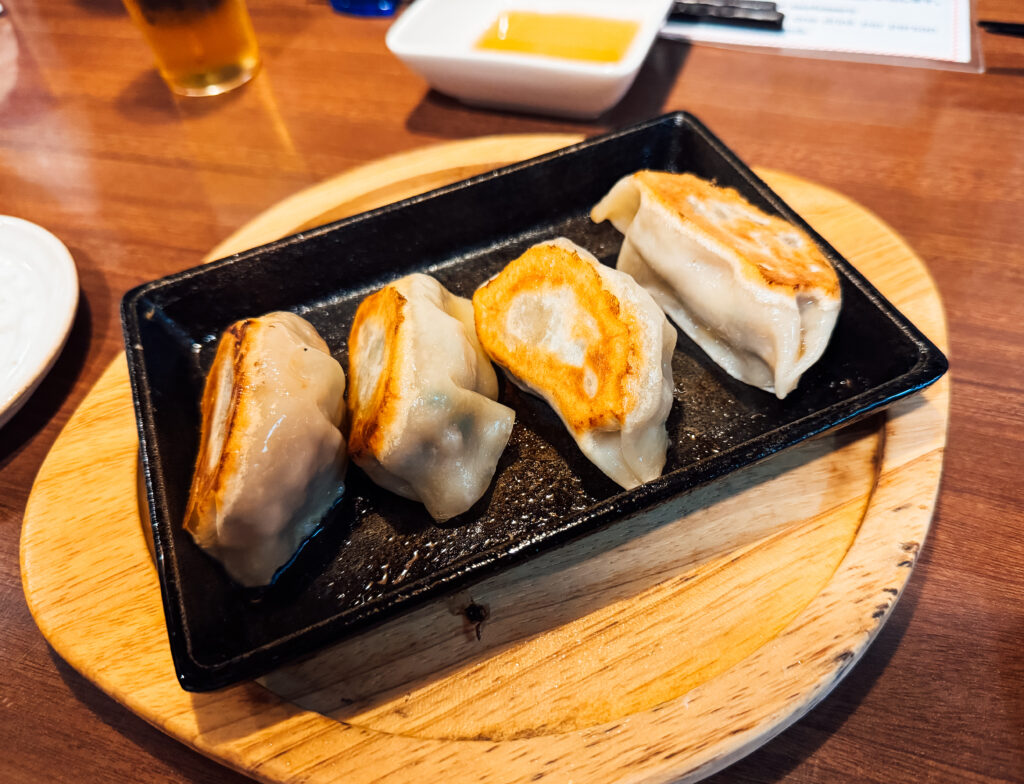
While gyoza is traditionally a Chinese dish, these savory dumplings are now found in many places in Japan. They are filled with meat and vegetables, wrapped in a thin dough, and pan-fried until the bottom of the gyoza is perfectly crisp. After being plated they are served with a gyoza dipping sauce.
A few of the best places to try gyoza in Japan:
- Chao Chao Gyoza – Kyoto
- Gyozaoh! – Osaka
- GYOPAO – Tokyo
- Izakaya all over Japan
TAKOYAKI IN JAPAN
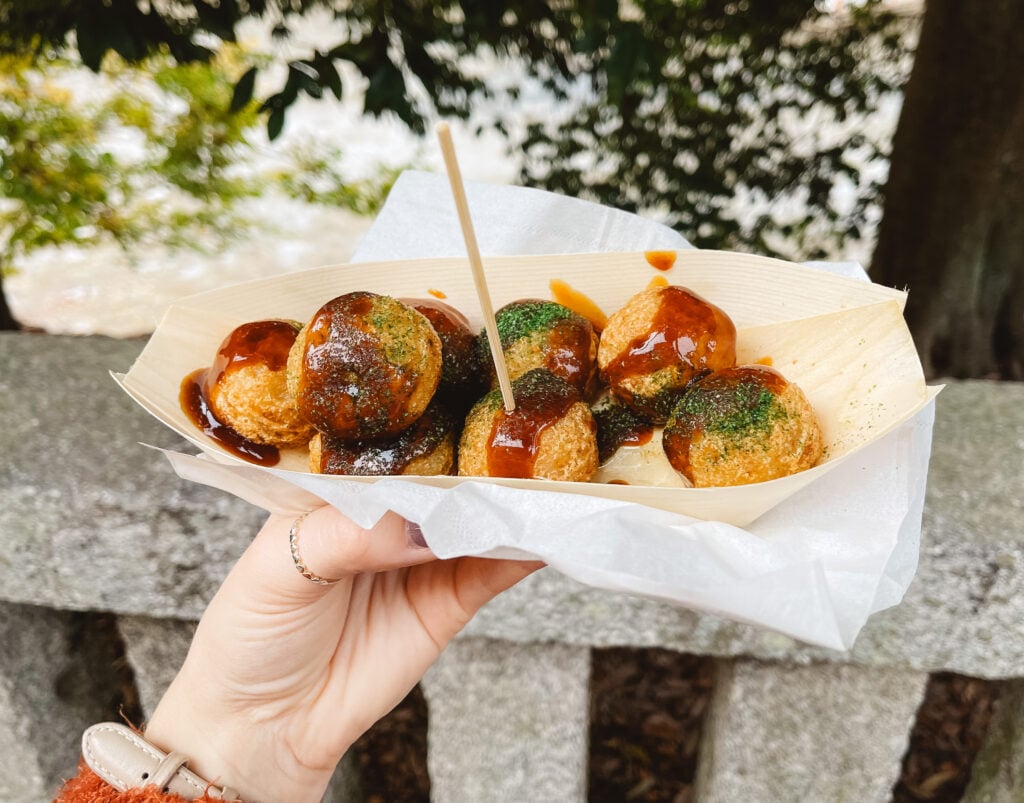
Takoyaki is a ball-shaped wheat flour-based snack that is typically fried and cooked inside a special Takoyaki pan that has round holes to make its shape. They are filled with octopus, tempura scraps, pickled ginger, and green onion. Then it is topped with a sweet and savory sauce, mayonnaise, and bonito flakes. Be careful after ordering and don’t eat them right away! They come out EXTREMELY HOT.
This popular dish is particularly famous in Dotonbori – Osaka and honestly, it would be a shame if you miss out on getting them there. We’ve had them in other cities too but they’re definitely not the same!
A few of the best places to try takoyaki in Japan:
- Takoyaki Yoriyabunzaemon – Osaka
- Takotakokingu Demaeten – Osaka
- Minami – Onomichi
ONIGIRI IN JAPAN
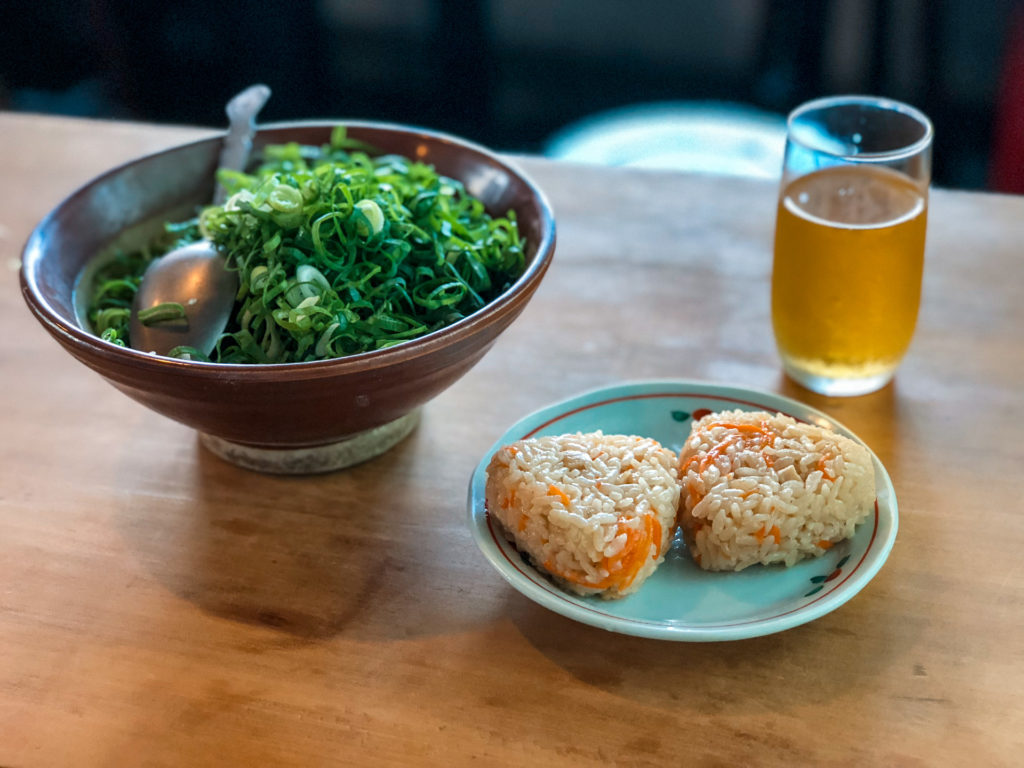
Onigiri is a triangular-shaped rice ball that has a variety of fillings. It makes the perfect snack, breakfast, or quick lunch item when on the go and you can find them in many flavors at konbini. But there are also onigiri shops selling fresh, homemade onigiri too! A few of our favorite flavors include tuna mayo, miso salmon, wasabi seaweed, and umeboshi (pickled plum).
JAPAN FOOD GUIDE: ENTRÉES
SUSHI IN JAPAN
When most people think of Japanese cuisine they probably think of sushi. Every time we visit Japan we try new sushi restaurants and visit our old favorites too. There’s truly nothing like getting fresh fish in Japan!
In the U.S. we also think sushi is elaborate rolls filled with fish, cream cheese, and vegetables then topped with a heavy amount of sauces that range from sweet to spicy. However, this is not the kind of sushi you’ll find in Japan. Instead, you’ll find the authentic, delicate, and relatively simple flavors of fish, rice, wasabi, and soy sauce.
If you’re used to the Westernized concept of sushi, this might come as a shock to you. But allow yourself to indulge in authentic sushi from one of the many high-quality restaurants. In this Japan food guide, here are the most common types of sushi you’ll see while in Japan.
Nigiri Sushi
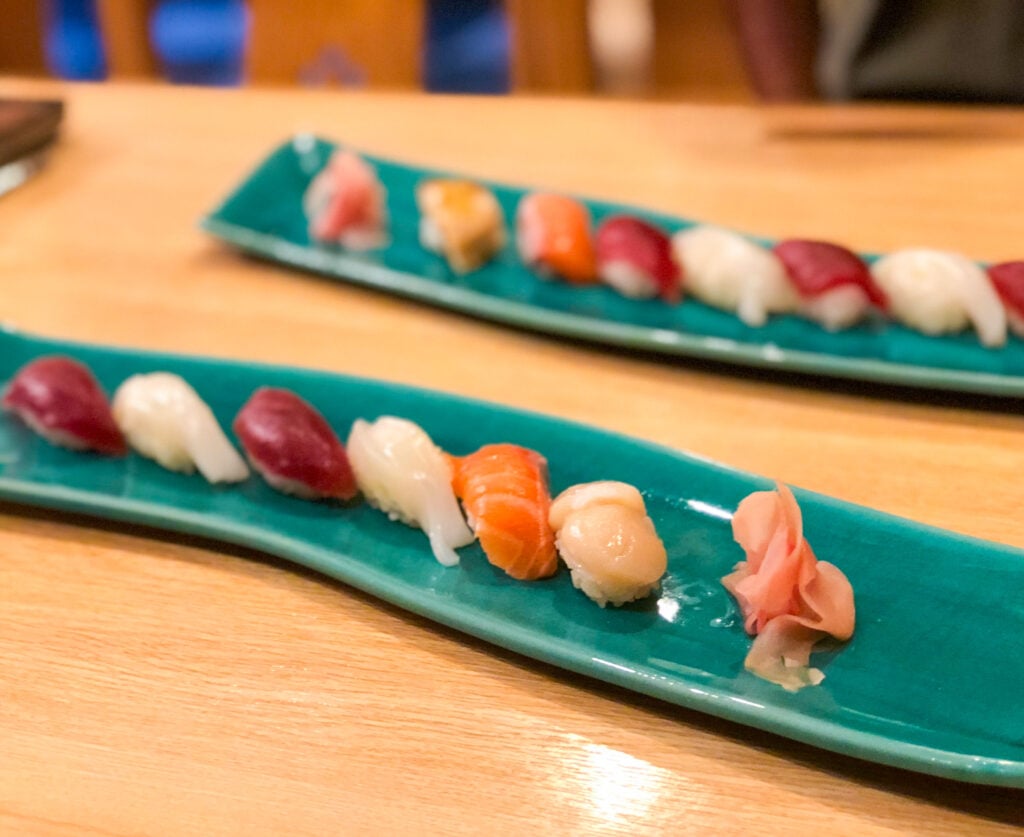
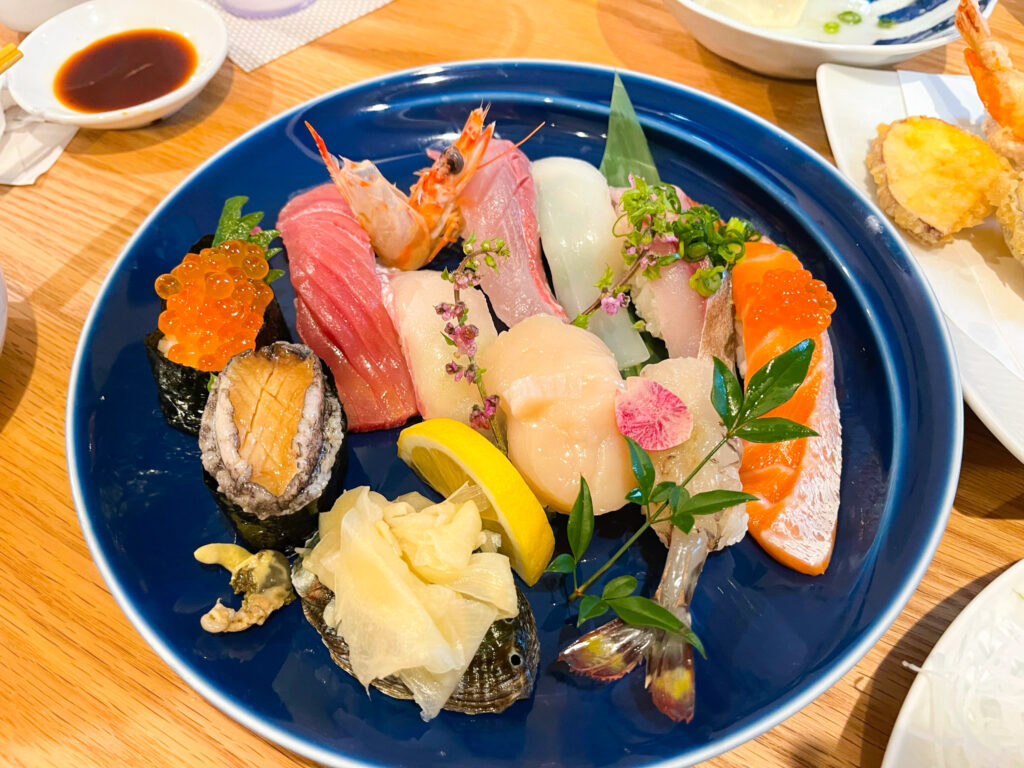
This is by far the most common form of sushi and also our favorite. Each piece of Nigiri is formed by hand by a sushi chef. The sushi rice is pressed into a rectangular or oval shape with a bit of wasabi spread on top then covered with a piece of fresh fish or other toppings before being artfully placed on a plate.
Many types of fish could be used but a few of the most common are freshwater eel (unagi), squid (
A few things to keep in mind while eating nigiri are that you do not have to use your chopsticks to eat each piece, and using your hands to eat is quite common when it comes to nigiri sushi. You will also want to make sure you don’t pour too much soy sauce into your dish as it can be considered taboo. Instead, pour a little bit at a time.
When dipping your piece of sushi in soy sauce, you’ll want to dip fish side down to not soak up too much as it can be an insult to the chef to add too much. Make sure you do not mix your wasabi with your soy sauce, your chef has already carefully considered how much wasabi to put on each piece but at conveyor belt sushi restaurants you can always add a little more if needed. Last, ginger is to be used as a palate cleanser, not to be eaten with your sushi.
Maki Sushi
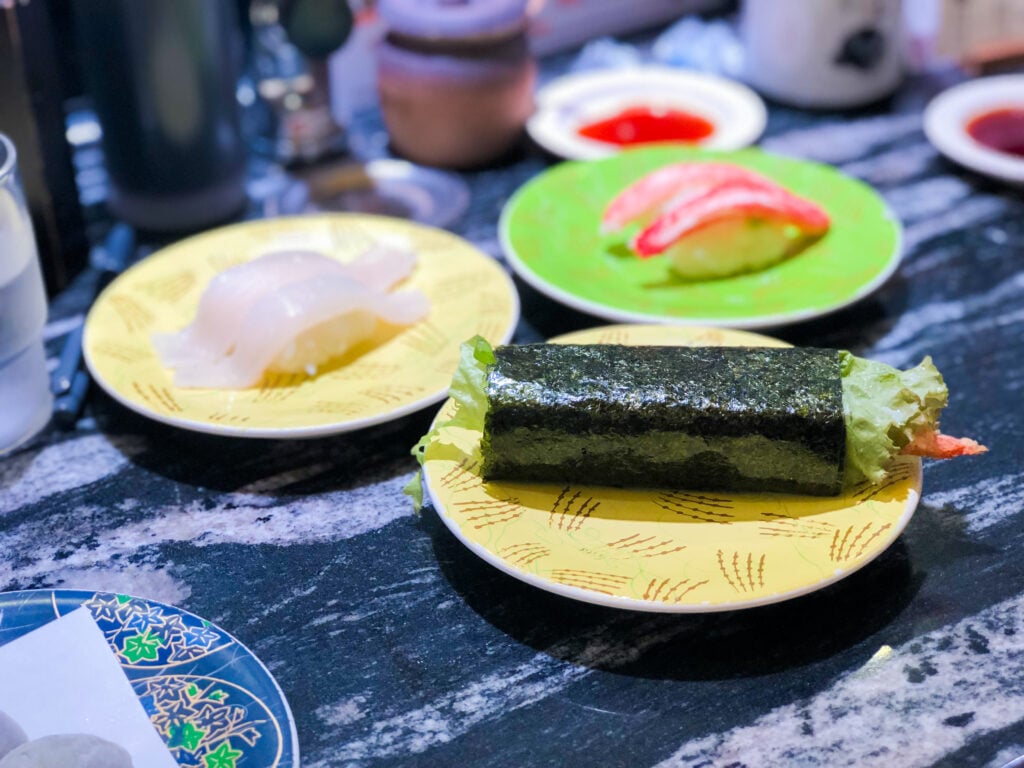
This is the form of sushi that we typically see at local sushi restaurants in the United States, although in Japan maki is much more basic and light. Maki is generally a sushi roll of rice and seaweed accompanied by vegetables or raw fish. Another way they are formed is as cone-shaped hand rolls where the rice and other ingredients are inside a larger piece of seaweed.
Sashimi
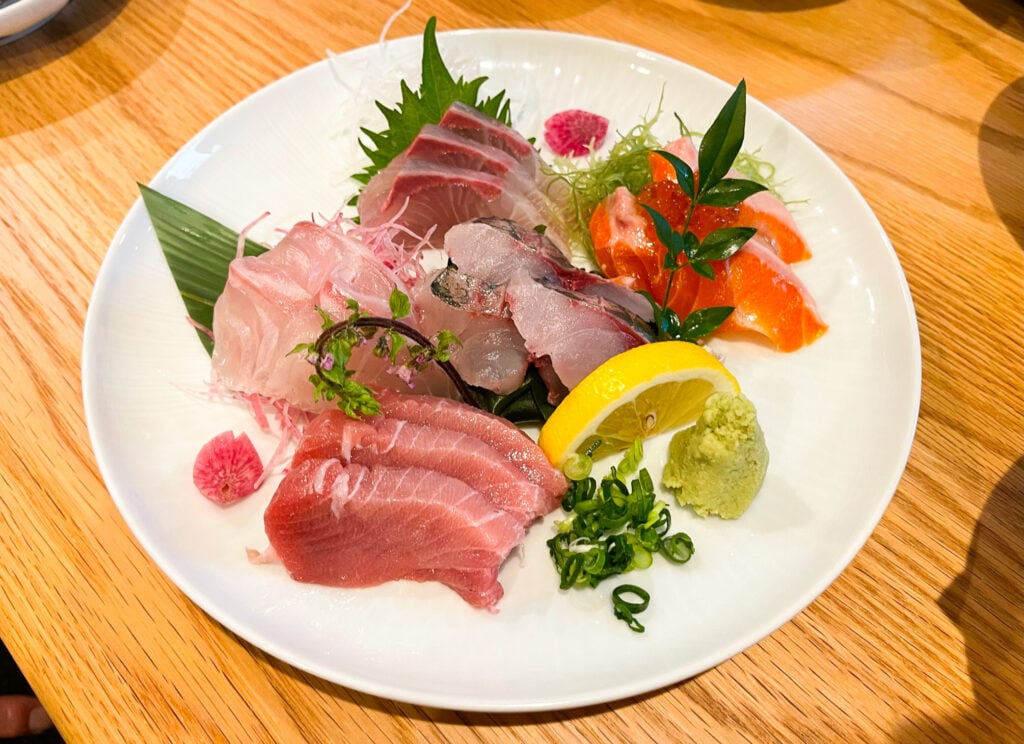
Sashimi is delicately sliced pieces of raw fish that are accompanied by soy sauce. When eating sashimi you’ll lay out one piece of fish and put a small amount of wasabi on top. Fold the piece in half or leave it whole and carefully dip it into your soy sauce and eat in one bite. Typically the fish is plated from lightest to darkest, providing you with an order in which to eat each piece.
A few of the best sushi restaurants in Japan:
- Sushi no Midori – Tokyo (Ginza)
- Nemuro Hanamaru – Tokyo (Ginza)
- Gonpachi – Tokyo (Shibuya)
- Sushi Hayata – Osaka
- Yonekichi Akira Sushi – Nikko
NOODLES IN JAPAN
We’re crazy about all the noodles in Japan. It is always one of the top choices for us as it makes for a delicious, quick, and inexpensive meal. Each style of Japanese noodles has different textures, ingredients, and widths, and is even prepared in different broths and various toppings. Don’t worry, w
Ramen
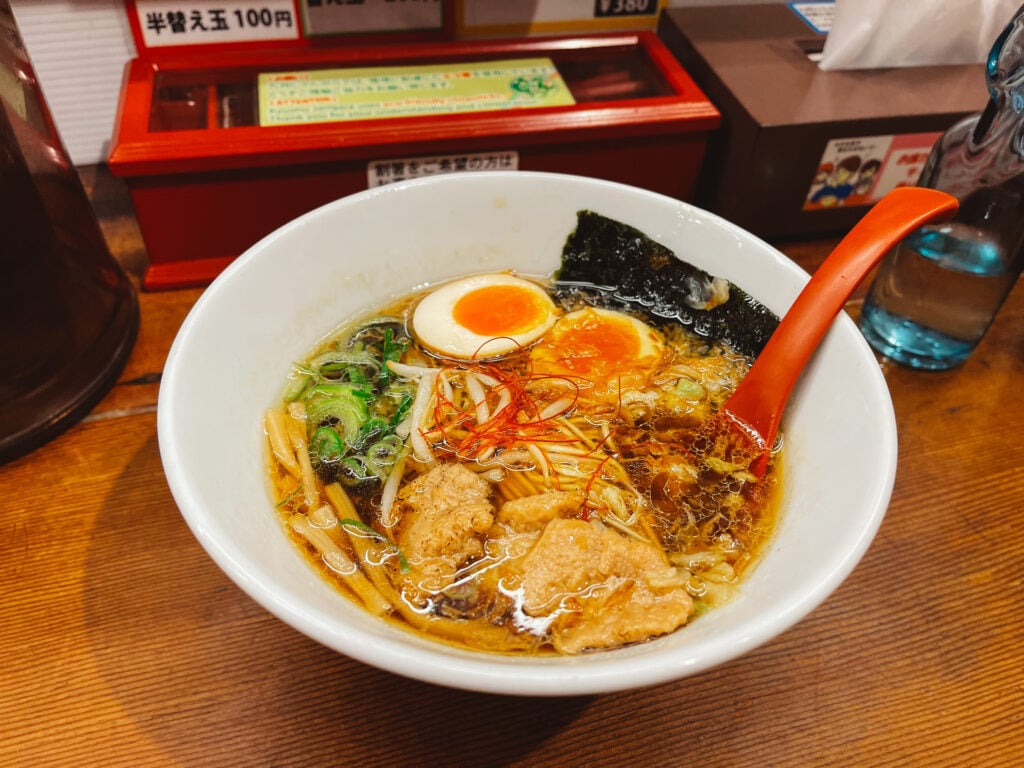
You won’t find any instant noodle packages in this Japan food guide. This ramen is as fresh as it gets. Ramen is a soup noodle dish that is made with thin noodles typically served in pork or occasionally chicken-based broth with a base of miso, salt, or
When eating ramen you’ll start by sampling the broth, after you can slurp your noodles so you can enjoy the broth and noodles together. As far as the other items go, you can eat them separately or together but it is most common to eat the egg separately (think of it as a side dish) and the mushrooms are meant to be eaten with the noodles. Don’t fear making a mess, slurp those noodles and enjoy!
A few of the best places for ramen in Japan:
- Ramen Stadium – Fukuoka
- Ide Shoten – Wakayama
- Ganso Asahikawa Ramen Ichikura – Asahikawa (Hokkaido)
- Menbakachidai – Kyoto
- Afuri – Multiple locations in the Tokyo area
- Ichiran – Multiple locations in Japan
Soba

Soba is another favorite of ours and can be eaten hot or cold which makes it the perfect dish to enjoy year-round while in Japan. Soba is a thin buckwheat noodle dish that is typically served with a hot or chilled dipping sauce. You may have some other items alongside your soba noodles and dipping sauce such as green onion and wasabi.
When eating soba you’ll take the wasabi and green onion and mix them in the dipping sauce. After, take a small portion of the noodles and dip them lightly in the sauce (don’t soak or pour the broth over the noodles) and slurp… yes slurping is polite in Japan!
After eating your soba noodles, your server will bring out
A few of the best soba shops in Japan:
- Sobanomi Yoshimura – Kyoto
- Kobayashi – Matsumoto
- Kanda Matsuya – Tokyo (Chiyoda)
Udon
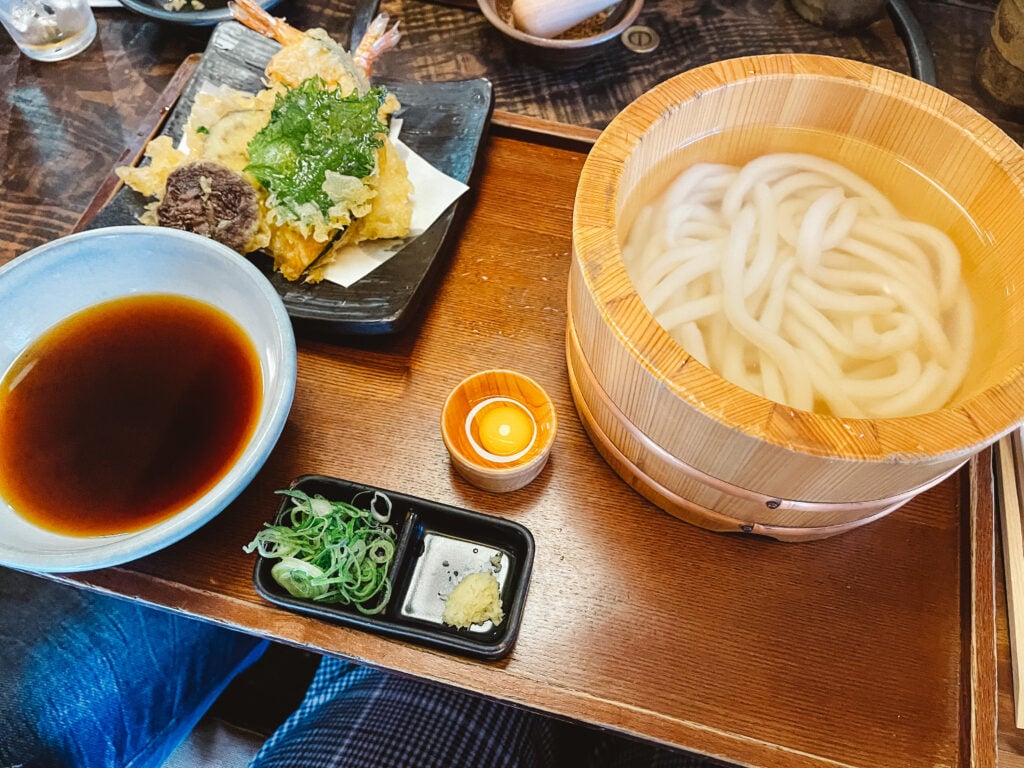
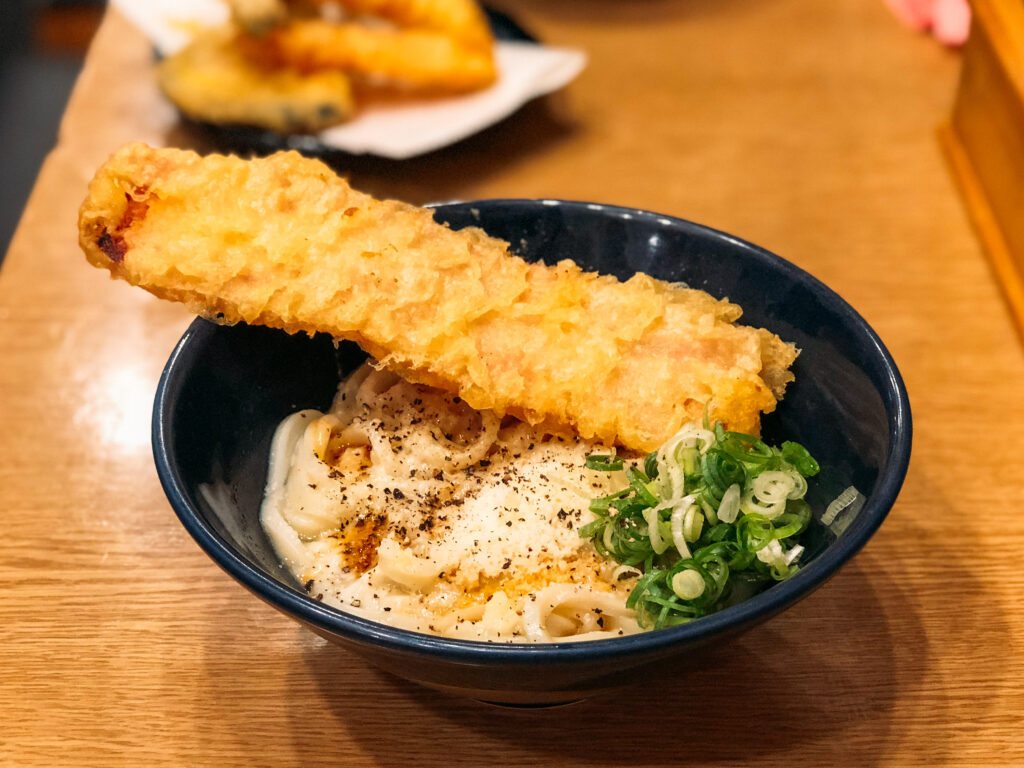
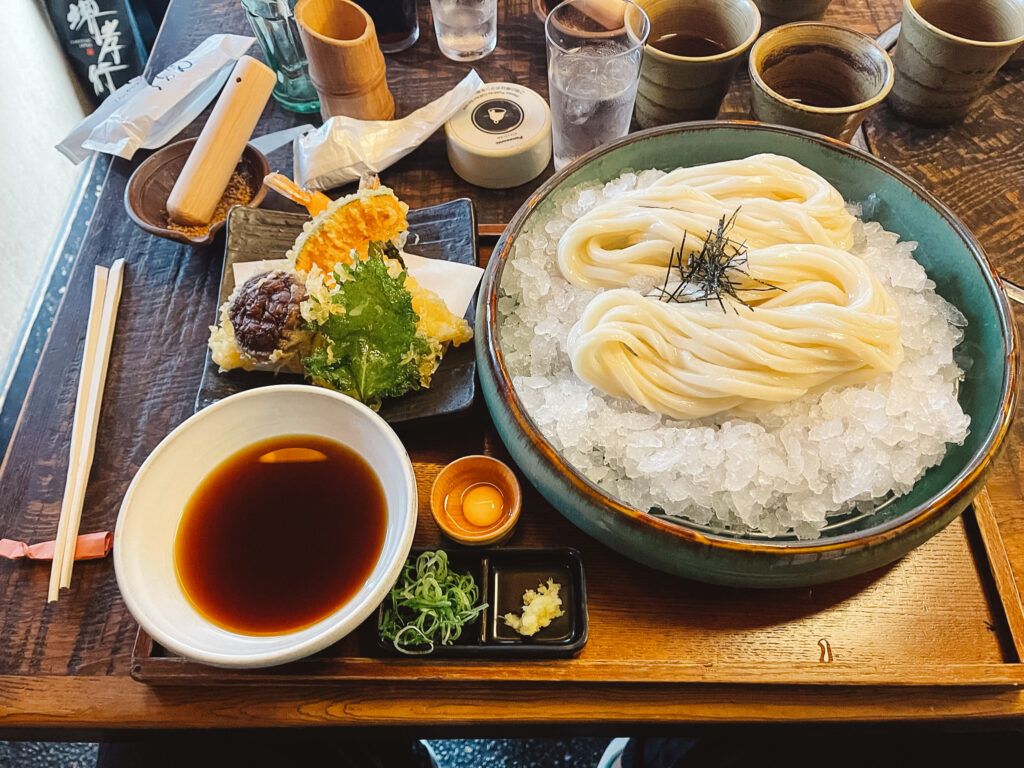
Udon is a thick and chewy noodle typically served hot or cold, inside a mildly flavored broth, or on the side with a dipping broth. It’s completely different from many other noodles in Japan and one of our favorites. We’re honestly convinced that noodles are soul food.
If served with a dipping sauce you’ll similarly eat them as we outlined with soba noodles. By taking a small number of noodles and lightly dipping them in the broth before slurping them up! If served inside the broth you’ll eat them like ramen slurping the noodles as you eat. After finishing you can drink the remainder of the broth directly from the bowl.
A few of the best places for udon in Japan:
- Tsurutontan – A few locations in Japan
- Udon Shin – Tokyo
- Marumi Shokudo – Ichinoseki
- Yamamotoya Honten – Nagoya
DONBURI IN JAPAN
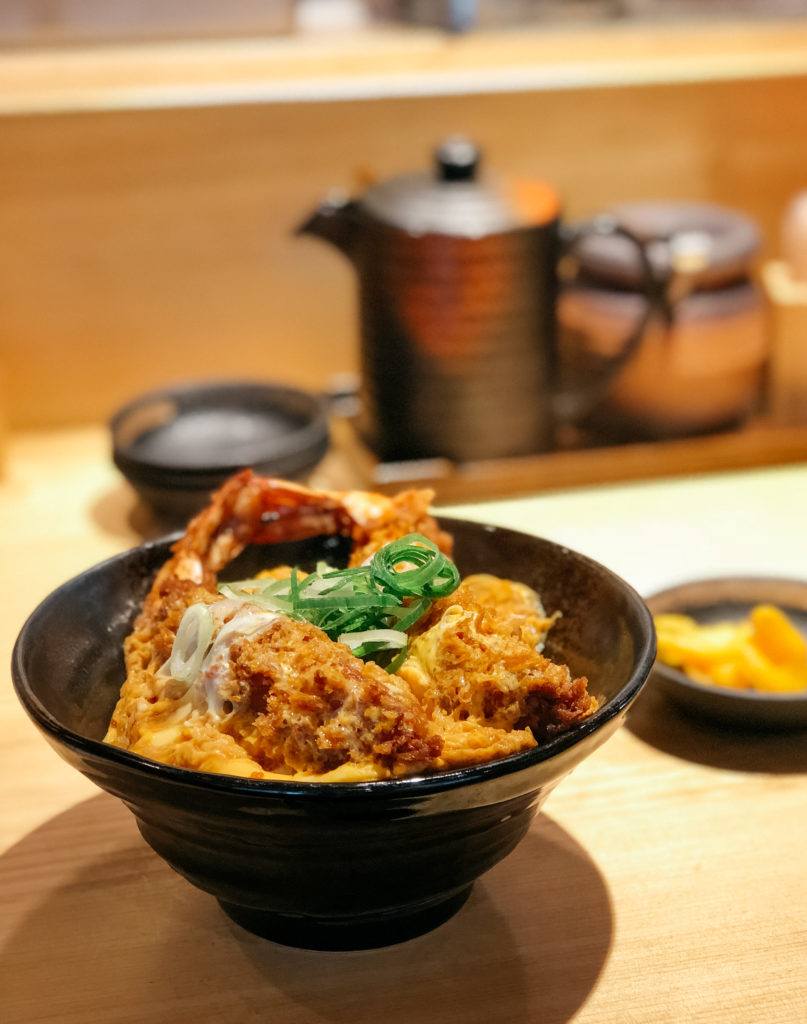
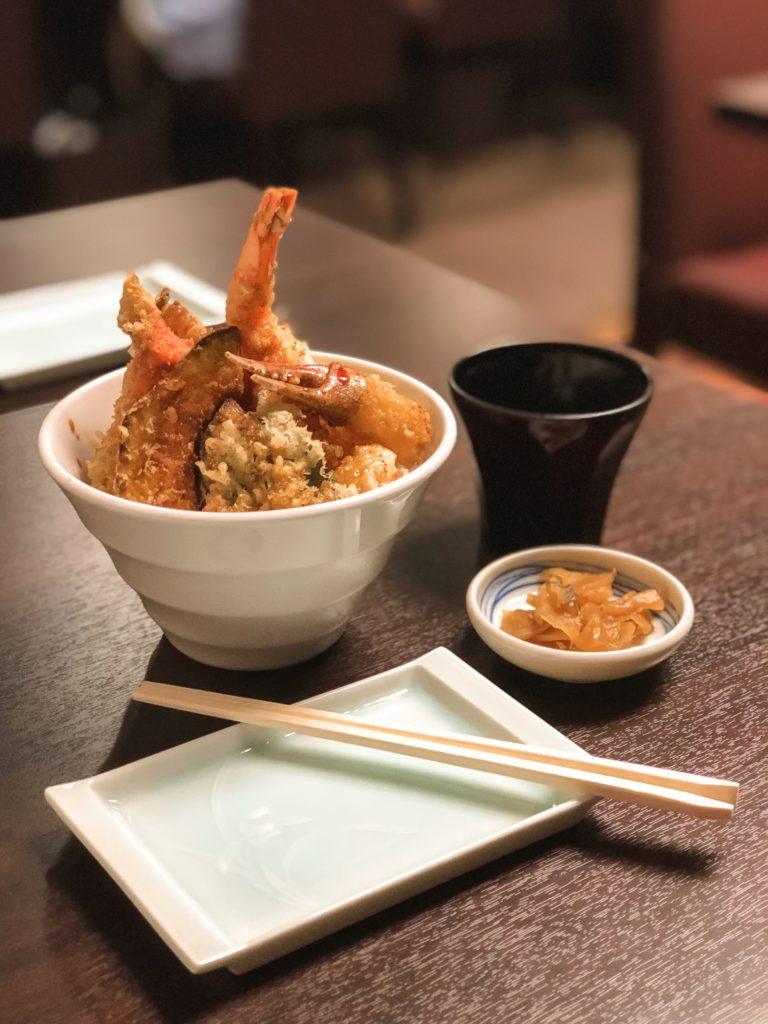
Donburi is a bowl of hot, white rice covered in a variety of toppings. It is a hearty, comforting dish. Some of the most popular include:
- Oyakodon – Rice bowl topped with chicken and egg.
- Gyudon – Rice bowl topped with thin slices of seasoned beef and grilled onions.
- Tendon – Rice bowl topped with tempura
- Unadon – Rice bowl topped with unagi (barbecued eel)
- Katsudon – Rice bowl topped with a fried panko pork or chicken cutlet
TEMPURA IN JAPAN
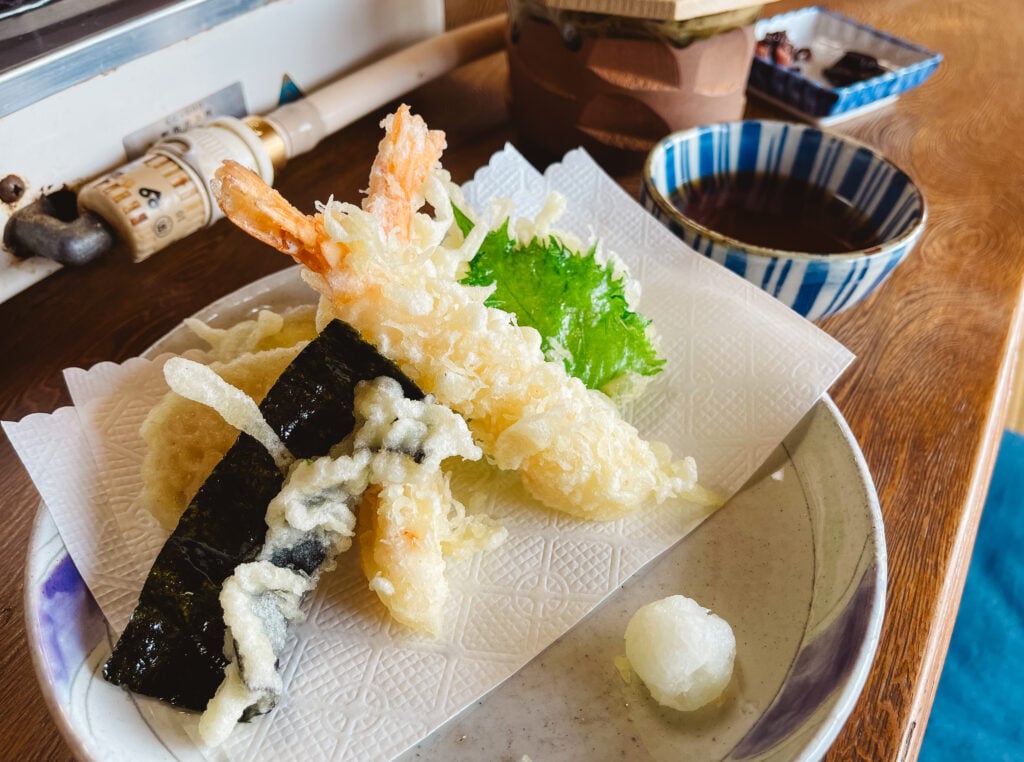
If you aren’t feeling super adventurous when it comes to Japanese food, I think that tempura might be a hit in our Japan food guide. We love the crispy, fried pieces of tempura as an addition to a noodle dish or as an entree itself! Usually, tempura contains seasonal vegetables, fish, prawns, and/or crab and if served as a dish can often be eaten with a bowl of rice. Tempura is also served with a dipping sauce and grated ginger or daikon radish as a palette cleanser when eating the salty, fried goodness.
A few of the best places for tempura in Japan:
- Ginza Tenkuni – Tokyo (Ginza)
- Tempura Abe – Tokyo (Ginza)
- Tempura Hirao – Fukuoka
KUSHIKATSU IN JAPAN
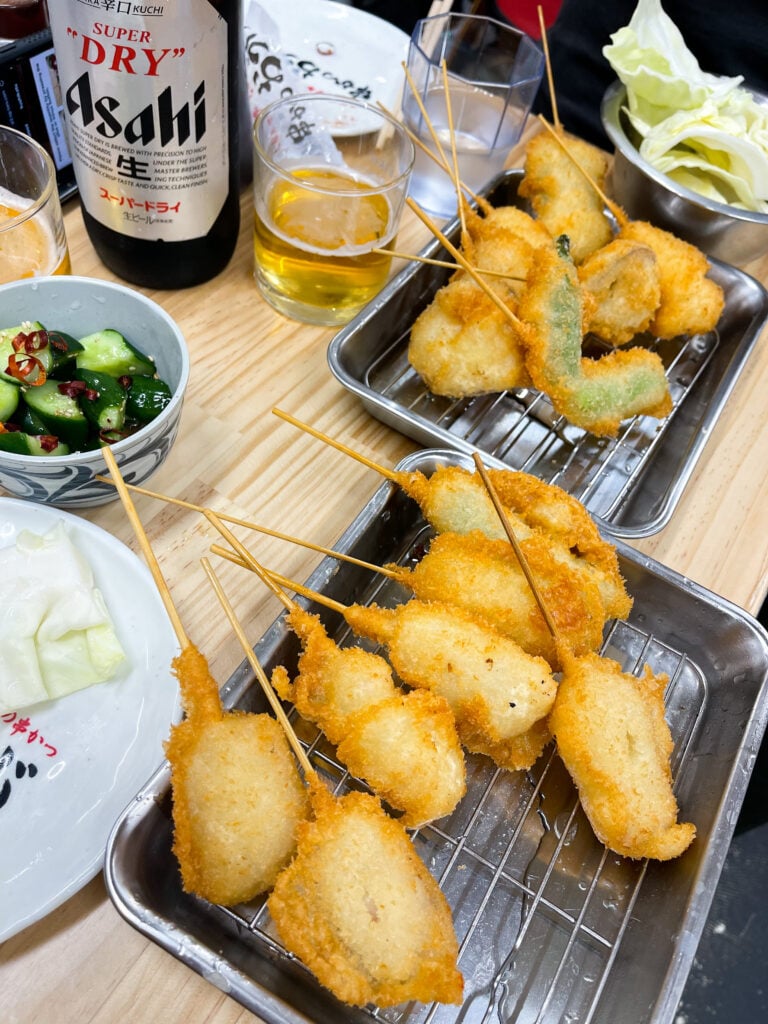
To keep up with our fried foods we want to introduce you to a fun dish in our Japan food guide known as
The main thing to know about kushikatsu is that under NO CIRCUMSTANCES should you ever, EVER double-dip in the kushikatsu sauce. Why? Because it is shared between yourself and many other people in the restaurant. However, if you go to a place where you can cook it yourself, you can have an individual bowl of sauce and I have noticed that since 2020 more places have the sauce in a container where you place some in a dish for yourself.
Another thing to keep in mind is that while each skewer is small, they fill you up quickly! Don’t let your eyes be bigger than your stomach and order too much because one, that’s wasteful, and two, it’s considered rude. Instead, order a few pieces at a time, you can always order more later!
A few of the best Kushikatsu restaurants in Japan:
- Kushikatsu Daruma – Osaka
- Kushikatsu Ouji – Osaka
- Kushiya Monogatari – Multiple locations all over Japan
TONKATSU IN JAPAN
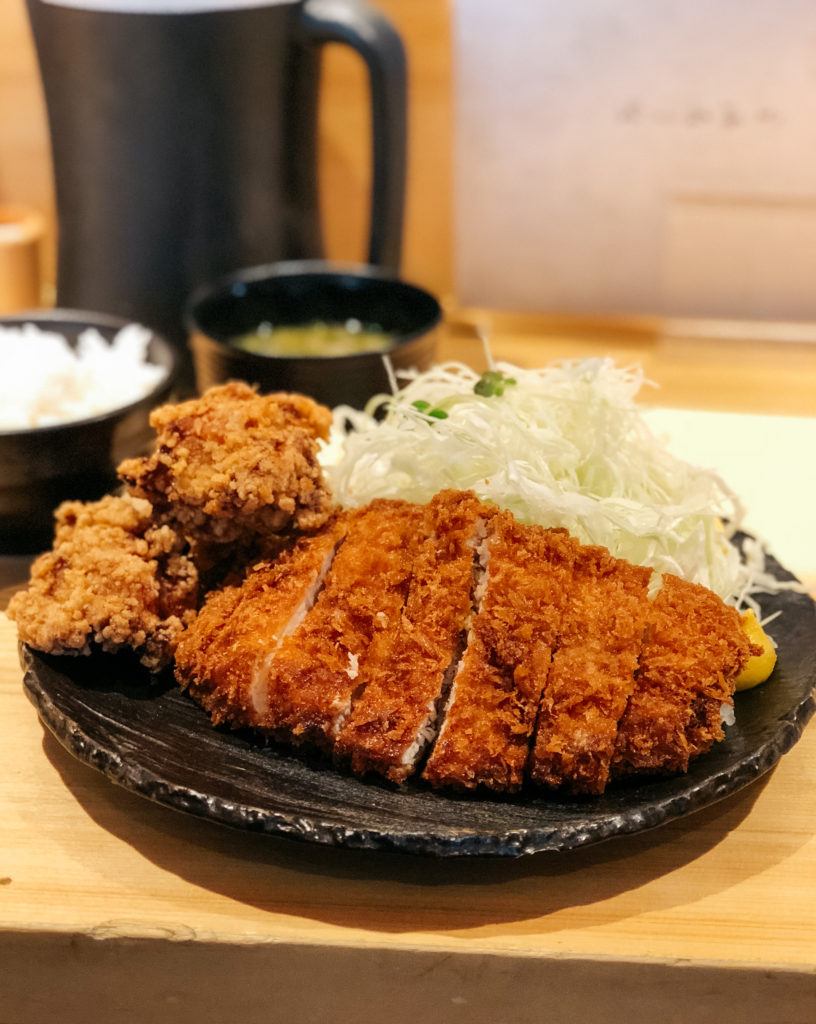
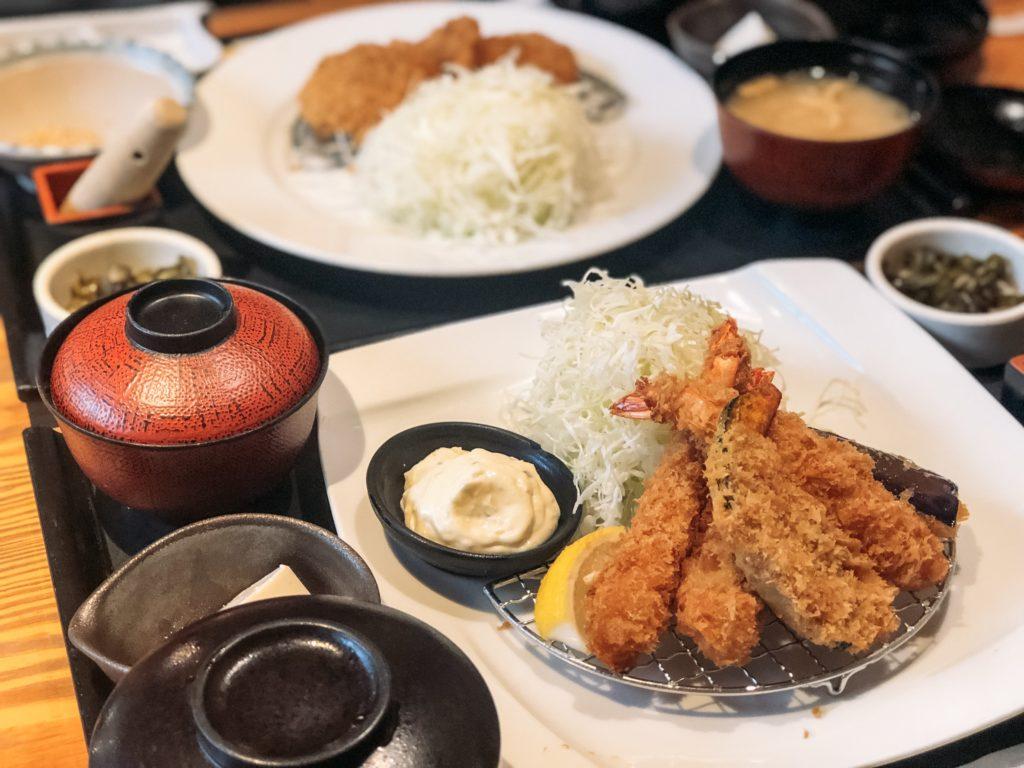
Tonkatsu is a dish that includes a crispy panko and deep-fried pork cutlet. It is typically served with a bowl of rice, cabbage, and miso soup that is often unlimited along with a special tangy tonkatsu sauce. Tonkatsu can also be found in other dishes like katsudon which is a tonkatsu cutlet over rice with egg or katsukare which is a tonkatsu cutlet with Japanese curry. Some tonkatsu restaurants also have other dishes like ebi fry (fried shrimp), crab croquette, or tori katsu (fried chicken).
A few of the best tonkatsu restaurants in Japan:
- Tonkatsu Ganko Nara – Nara
- Katsukura – Kyoto
- Meijitei – Nagano
- Tonkatsu Tonsho – Tokyo (Asakusa)
NABEMONO IN JAPAN
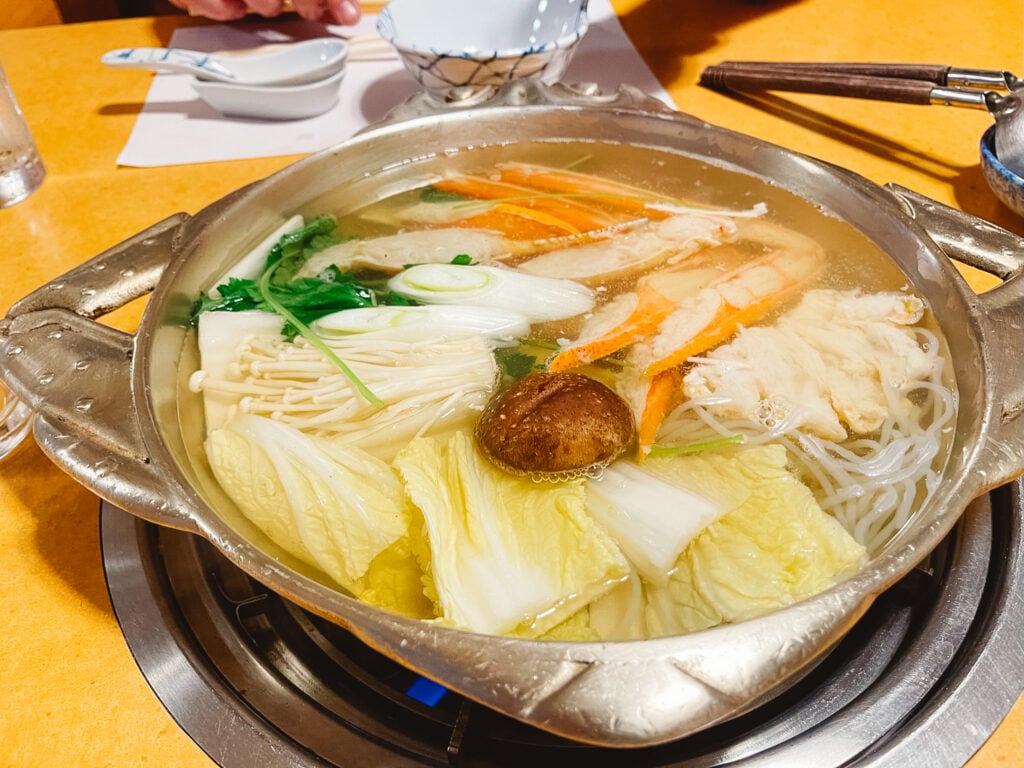
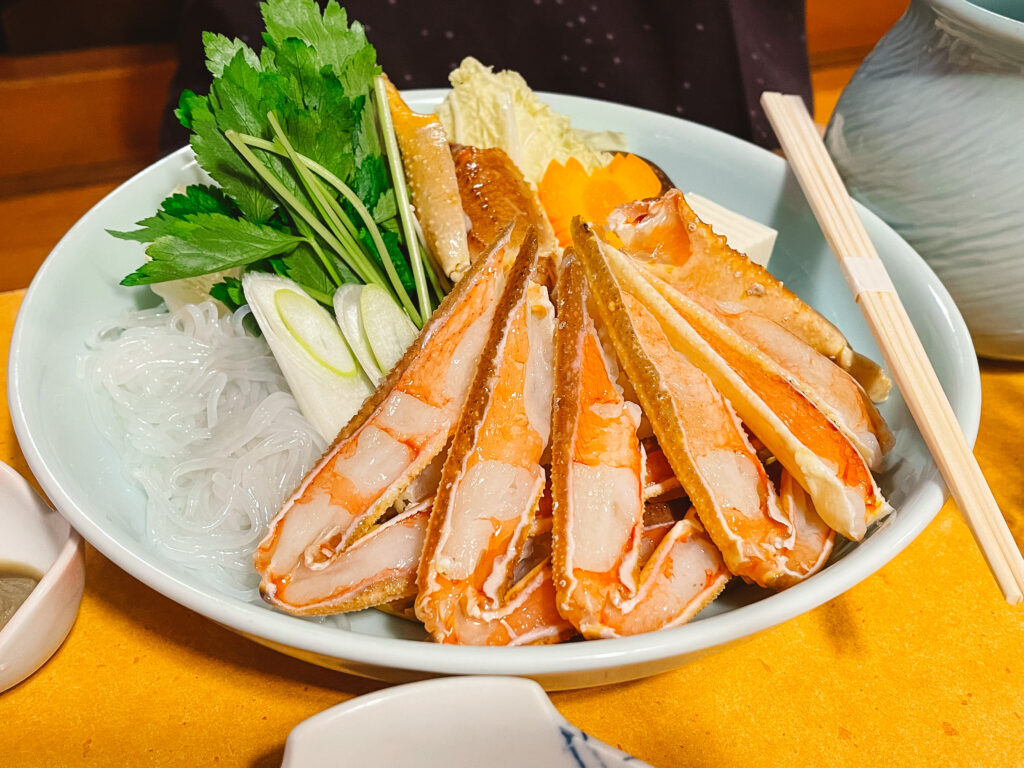
Nabemono refers to one-pot dishes that are done hot pot style with broth and vegetables, meat, and/or seafood to cook. There are a variety of nabemono dishes like shabu shabu, sukiyaki, and chirinabe. Shabu-Shabu is a dish that features thin slices of meat and vegetables that are cooked in water or a light broth. Although, when it comes to the meat, you won’t be leaving it in the boiling broth to cook. Instead, you’ll take one piece at a time gently moving it around in the broth.
Sukiyaki is very similar to shabu shabu but this time you will be putting the ingredients into a pot of simmering broth to cook. Sukiyaki hot pot dishes usually contain a variety of seasonal ingredients such as thinly sliced meat, seafood, vegetables, mushrooms, and tofu.
A few of the best places for nabemono or hot pot:
- Kani Doraku – Osaka and Kyoto
- Hakata Hanamidori – Fukuoka
YAKINIKU & STEAK IN JAPAN
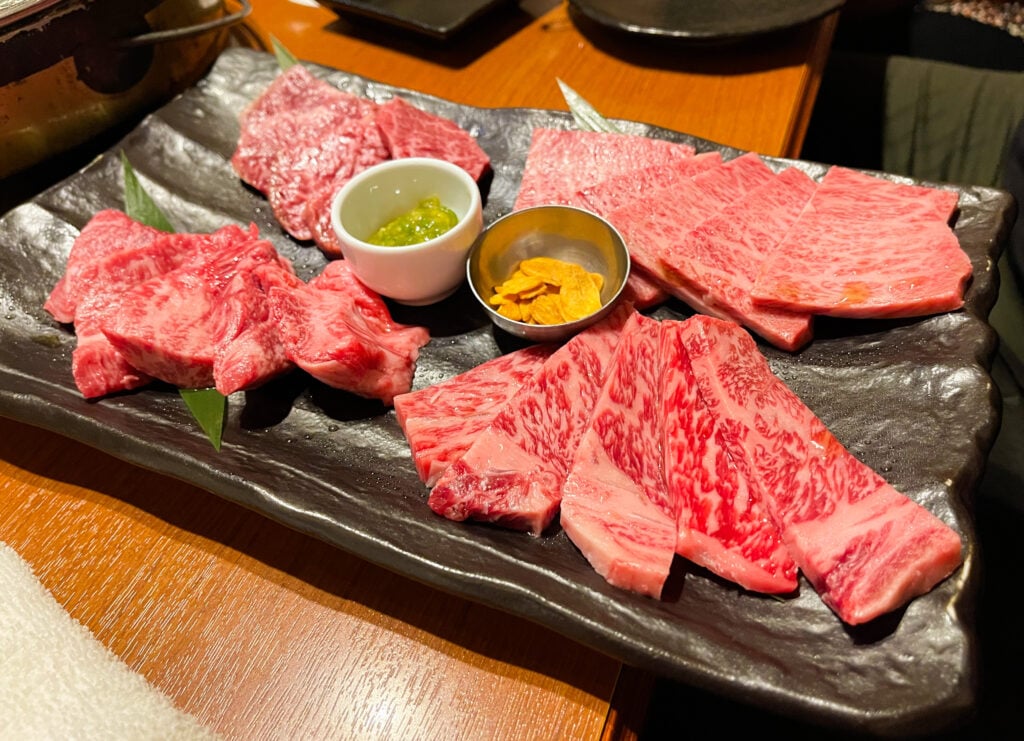
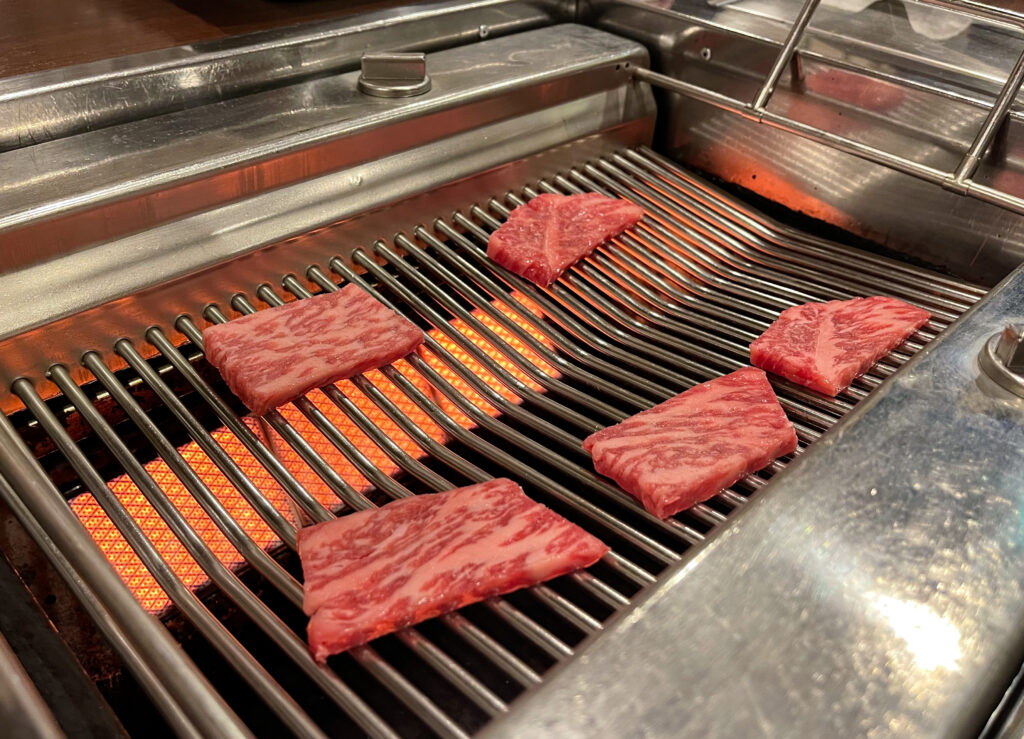
Yakiniku means “grilled meat” and you’ll find all different kinds of
Typically you’ll see skewers of grilled beef as street food, at Izakayas (bars), or even in restaurants. For a more expensive option, you can visit a restaurant that offers prime beef cuts such as Wagyu, Kobe, and Matsuzaka served with soy sauce, wasabi, and salt for dipping – however, if you get a REALLY good cut, you won’t need to add anything.
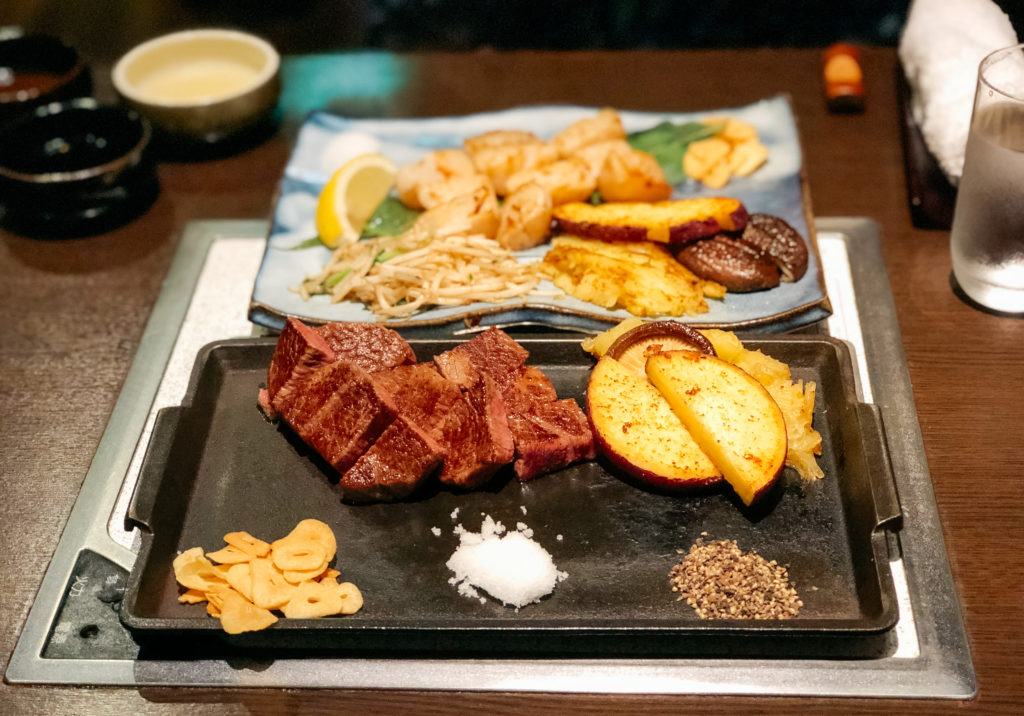
A few of the best places for yakiniku in Japan:
- Nanzan – Kyoto
- Yakiniku M Hozenjiyokocho – Osaka
- Mouriya – Kobe
- Kuroyaki – Hiroshima
OKONOMIYAKI IN JAPAN
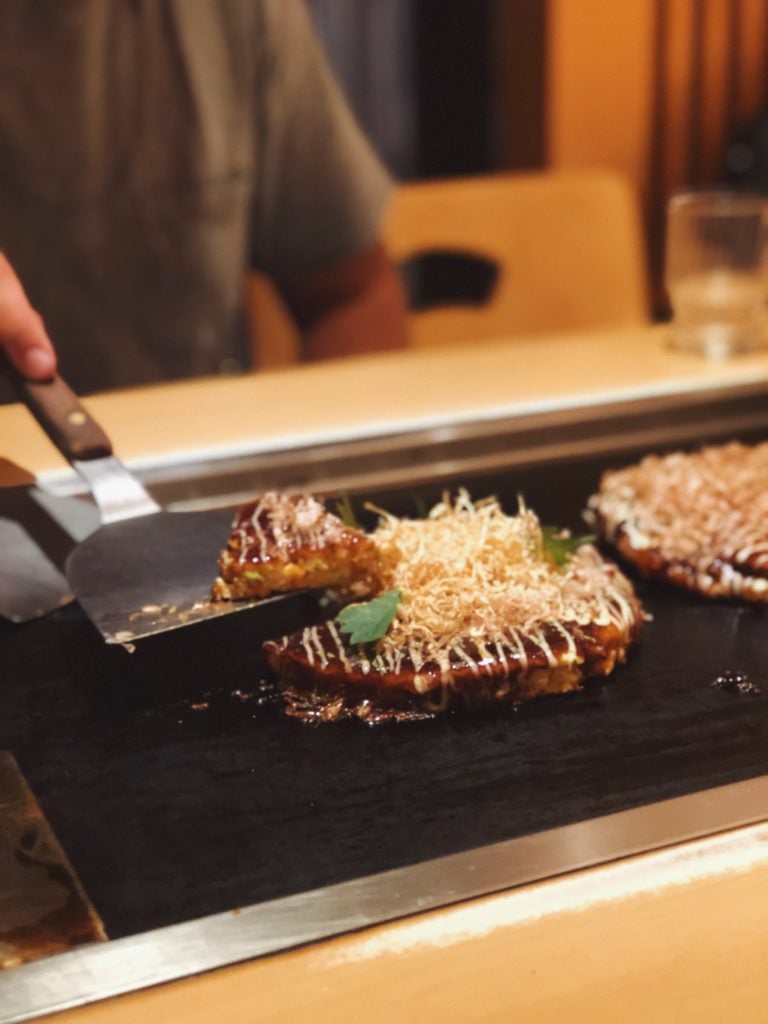
Okonomiyaki is a Japanese savory pancake. This generously portioned dish became popular in the Hiroshima region but has since expanded all over Japan with different variations. In Hiroshima, it is typically made with cabbage, egg, noodles, and a choice of meat (pork, octopus, squid, shrimp). It is then fried and topped with a sweet and savory sauce, mayonnaise, green onion, and bonito flakes. The Osaka (Kansai) version of okonomiyaki is similar to the Hiroshima style but does not have noodles.
A few of the best places for okonomiyaki in Japan:
- Okonomiyaki Sakaba O – Osaka
- Hassei – Hiroshima
- Okonomiyaki Parco – Nara
- Tsurujirō – Tokyo (Asakusa)
- Donguri – Kyoto
JAPANESE CURRY
Japanese curry is one of my favorite comfort dishes to eat in Japan and make at home! It is commonly served over rice but you can also find curry udon and curry bread! Typically Japanese curry is packed with vegetables like onions, carrots, and potatoes along with some sort of meat such as chicken, beef, or pork.
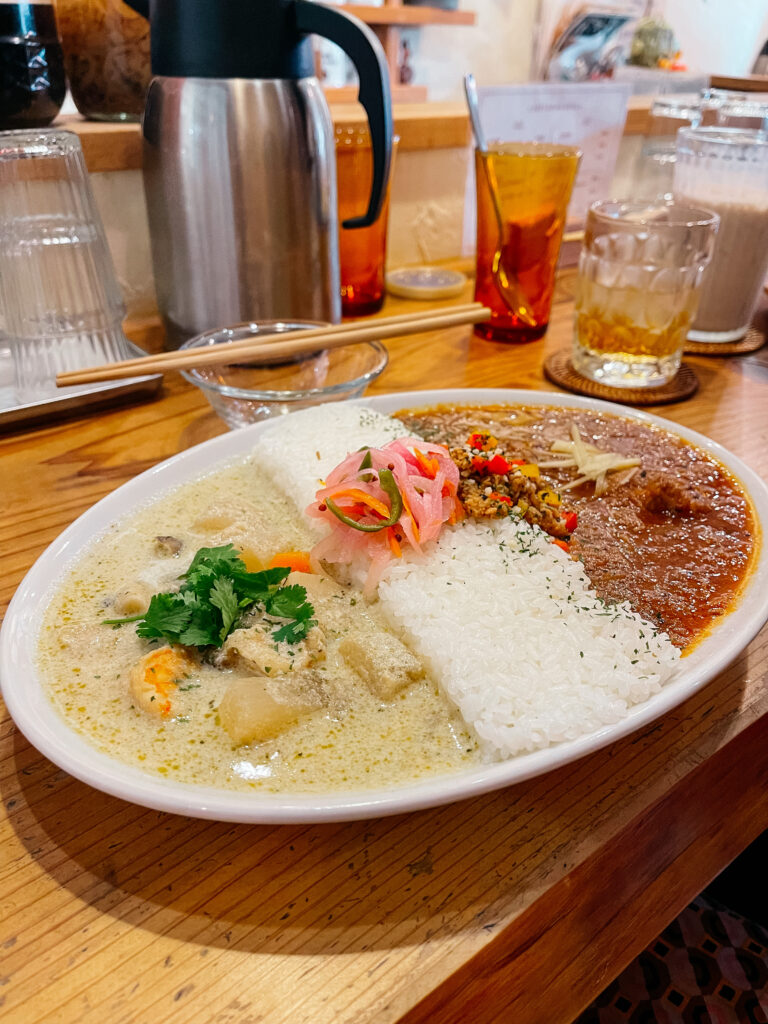
A few of the best places for curry in Japan:
- CoCo Ichibanya – Multiple locations all over Japan
- Spice Suehiro – Himeji
- Bondy – Tokyo
- Joto Curry – Tokyo (Shibuya)
YAKITORI IN JAPAN
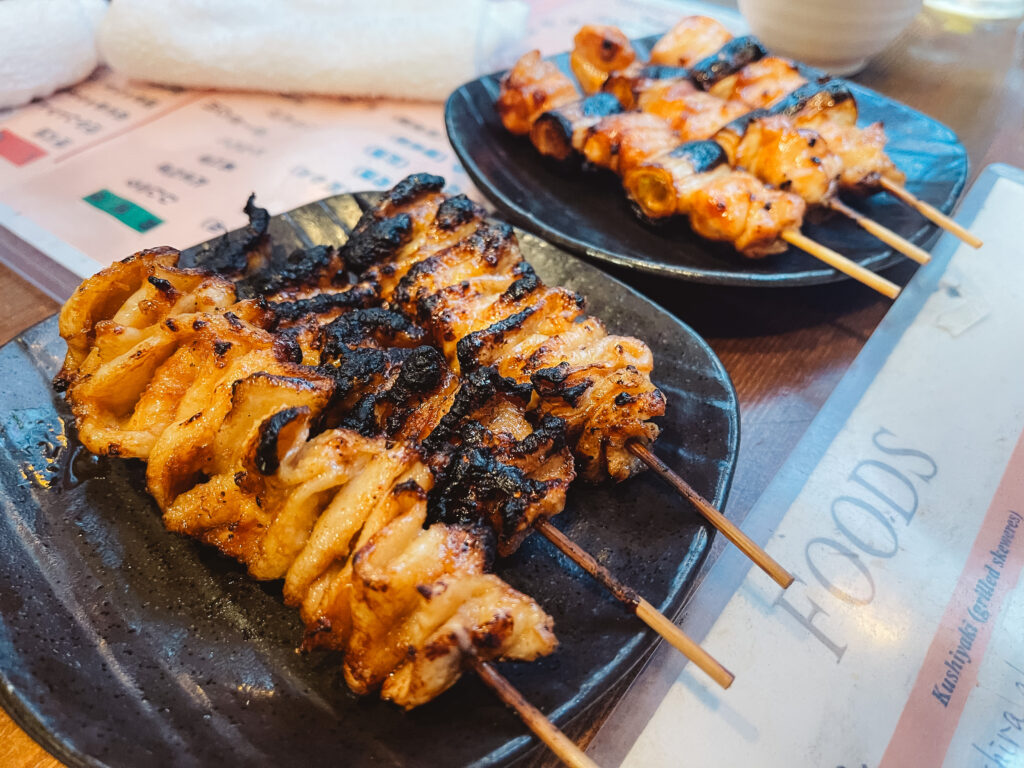
Yakitori is a dish of various parts of chicken such as chicken thigh, skin, hearts, gizzards, liver, etc. These pieces are skewered and grilled over a charcoal fire. It is usually seasoned with salt or a sauce called tare which is made from soy sauce, sake or mirin, and sugar.
The best places to try yakitori in Japan:
- Nogataya – Tokyo (Shinjuku)
- Yakitori Moe – Tokyo (Roppongi)
- Kushidori – Asahikawa (Hokkaido)
- Tokin – Fukuoka
READ MORE: Ice Cream in Japan
TOFU IN JAPAN
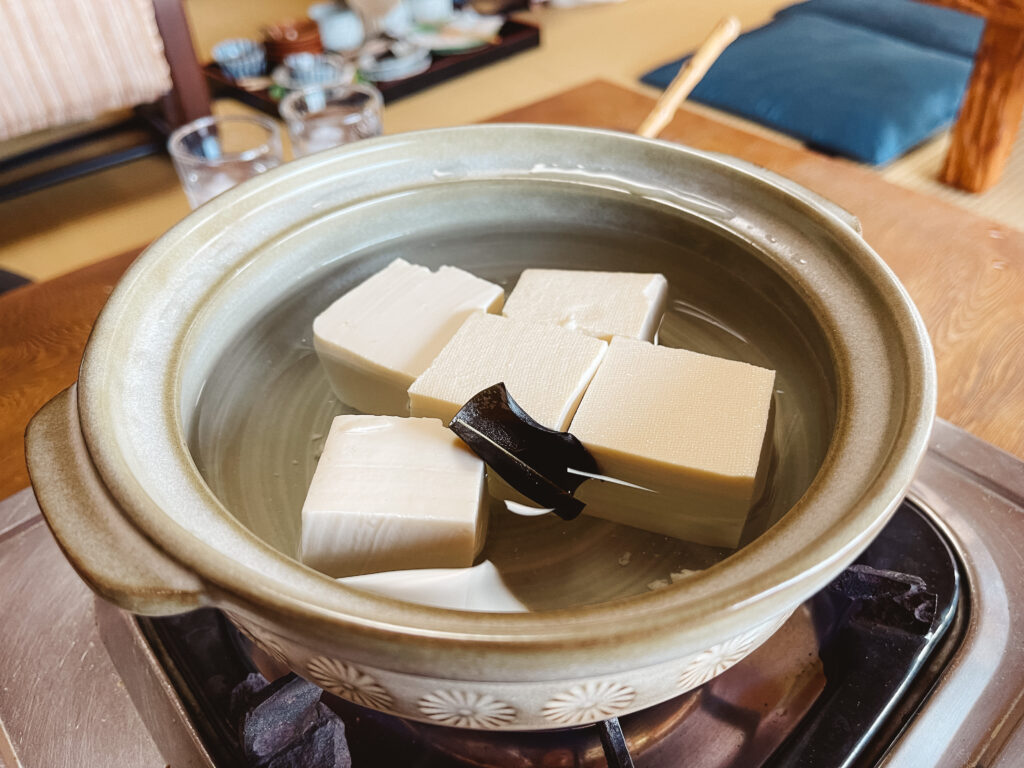
If you think you don’t like tofu because you’ve had it from the grocery store, I implore you to try it again while in Japan. Homemade tofu is exceptional and you can try it in a variety of different ways like yudofu (tofu hot pot), yuba (soymilk skin), and even tofu pudding. Because Kyoto has a large production of soybeans, tofu cuisine is very popular in the Kyoto Prefecture and there are many restaurants with homemade tofu on the menu!
A few of the best places to try tofu in Japan:
- Yudofu Kisaki – Kyoto
- Tousuiro Kiyamachi – Kyoto
- Shoraian – Kyoto
- Yubamaki ZEN – Nikko
BENTO IN JAPAN
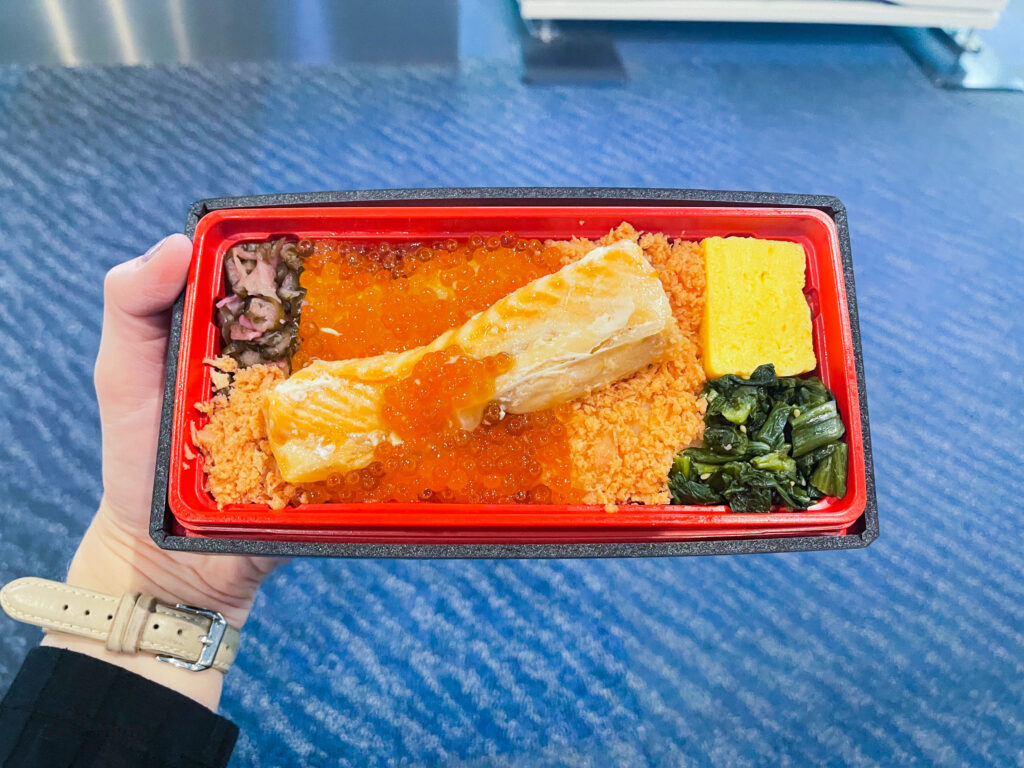
A bento is a take-out or homemade meal that is often bought or taken for lunch. One place you can commonly find bento is inside shinkansen stations. These bento are called ekiben (train bento) and are commonly served in containers made from plastic, wood, or ceramic, some are even keepsake containers. Many ekiben are made with local cuisine making them different in each shikansen.
IZAKAYA IN JAPAN
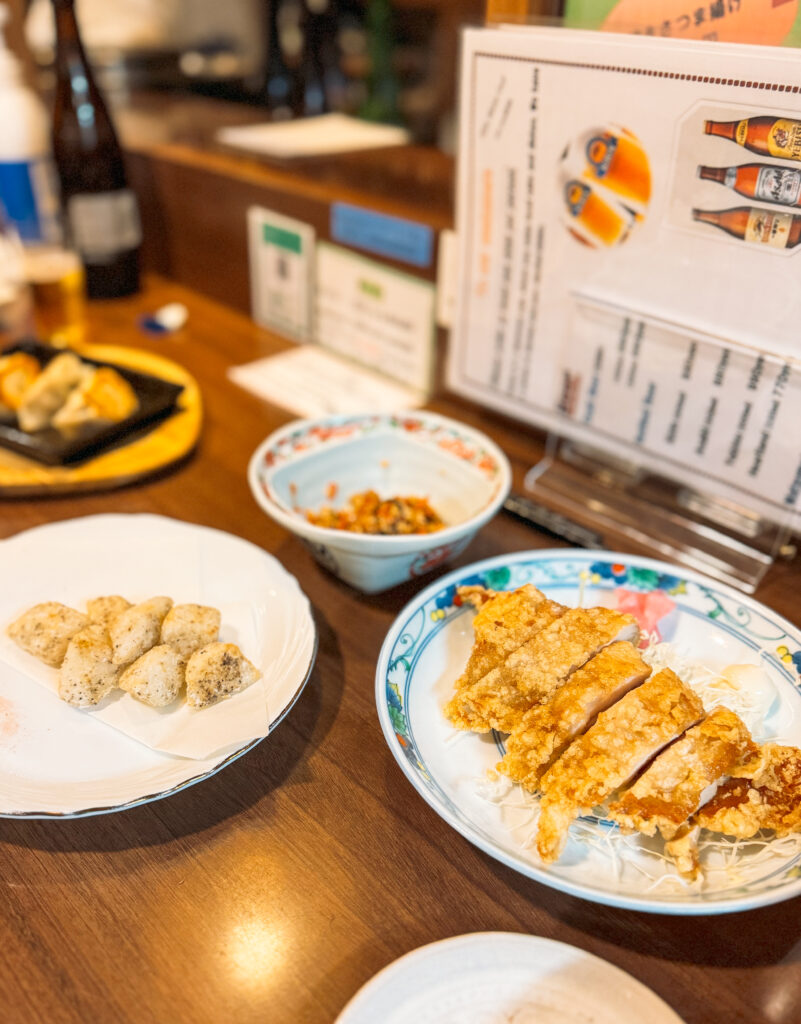
Izakaya are a type of informal pub that serves various Japanese comfort dishes. They are often very small establishments typically with 8-15 bar stools but some have small seating areas as well. They’re a great place to go and try several different small plates like yakitori, sashimi, yakisoba, tsukemono (pickles), karaage (fried chicken), and other various items.
The best izakayas we’ve visited in Japan:
KAISEKI IN JAPAN
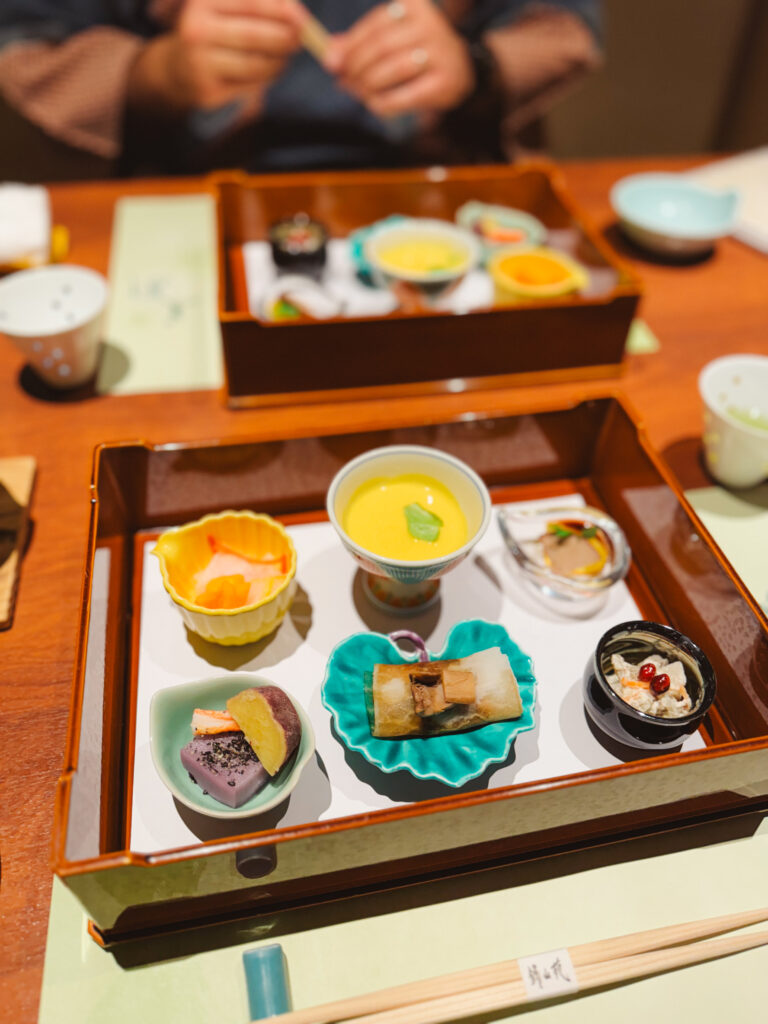
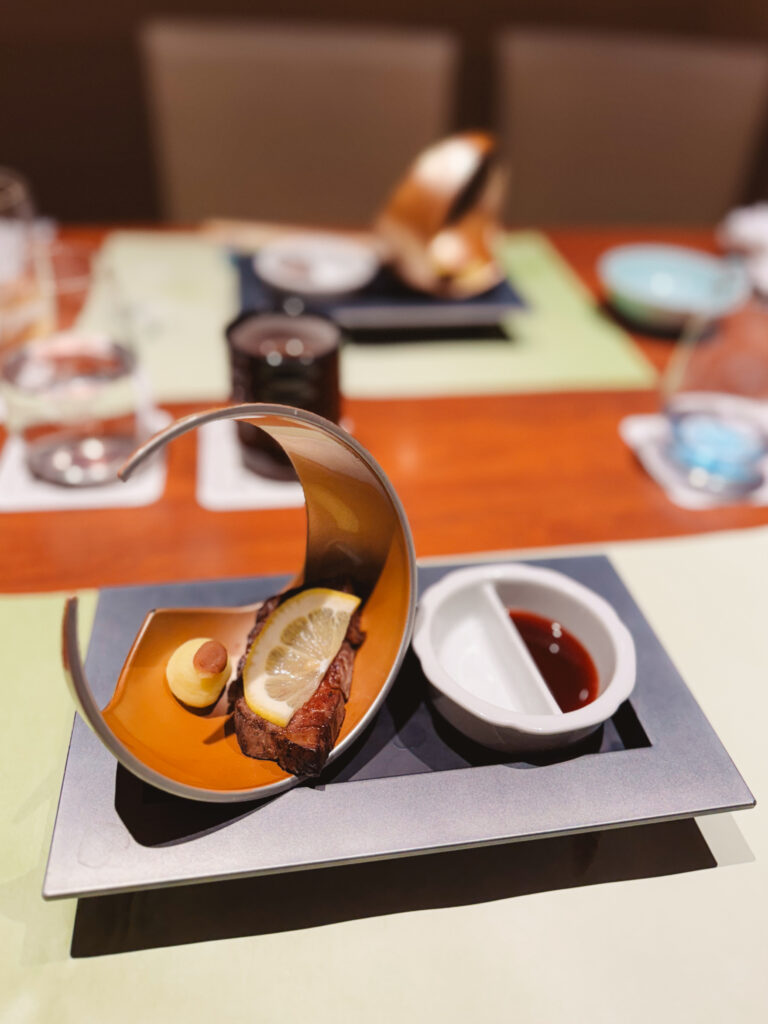
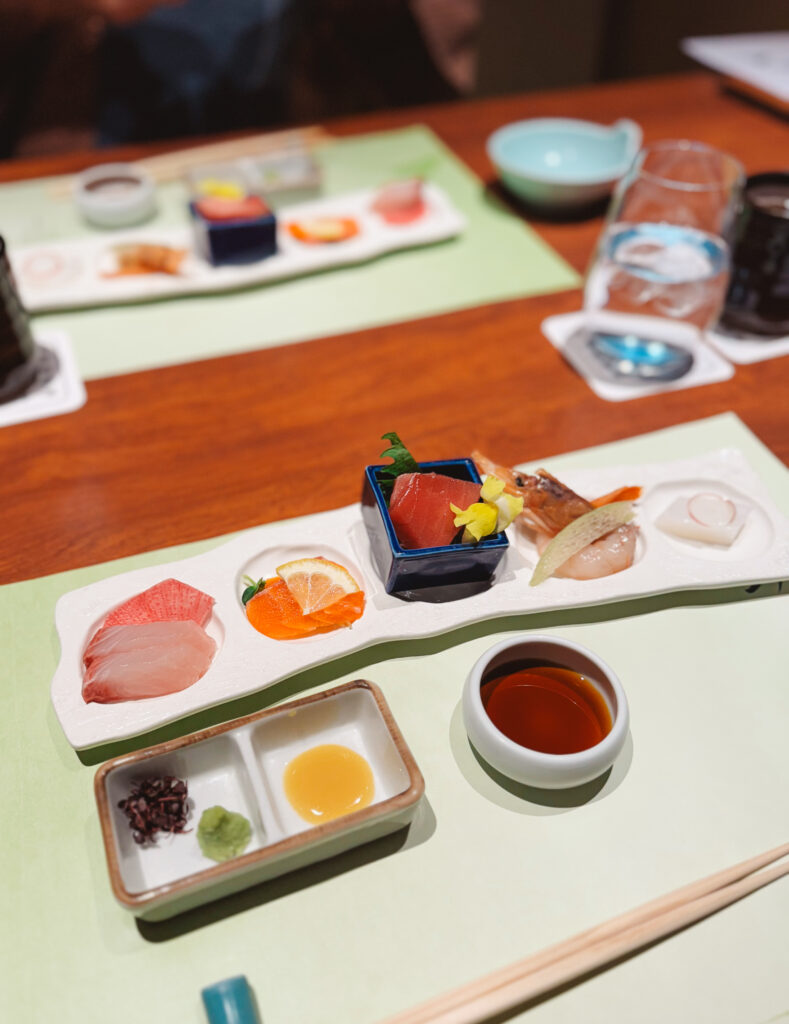
Kaiseki is the most unique item on this food guide for Japan. It is a traditional multi-course Japanese meal that often features small portioned artistically arranged dishes. All of the ingredients are mindful of the season and are often locally sourced to provide the freshest taste. One of our favorite kaiseki dining experiences was when we visited Kinosaki Onsen.
READ MORE: A Sweet Guide to Japanese Desserts
DRINKS IN JAPAN
COFFEE IN JAPAN
Much like in the United States, coffee is served hot or cold in Japan and you can find coffee in all different forms in Japan. We enjoyed sipping on espresso drinks from local coffee shops, grabbing coffee at a konbini, or even selecting a Boss iced coffee from a nearby vending machine.
Here are some of our favorite coffee shops in Japan:
- Weekenders Coffee Roastery – Kyoto
- % ARABICA – Kyoto
- HillBilly Coffee – Magome
- CAMELBACK – Tokyo
- LATTEST – Tokyo
- Doutor – Chain coffee shop
JAPANESE TEA
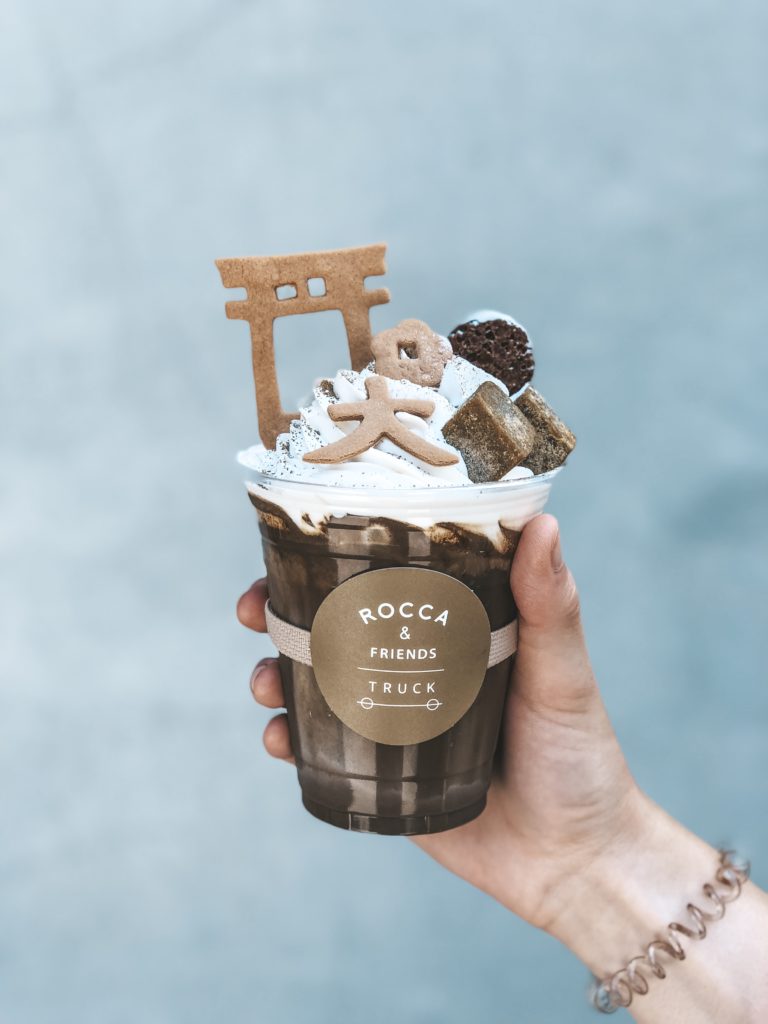
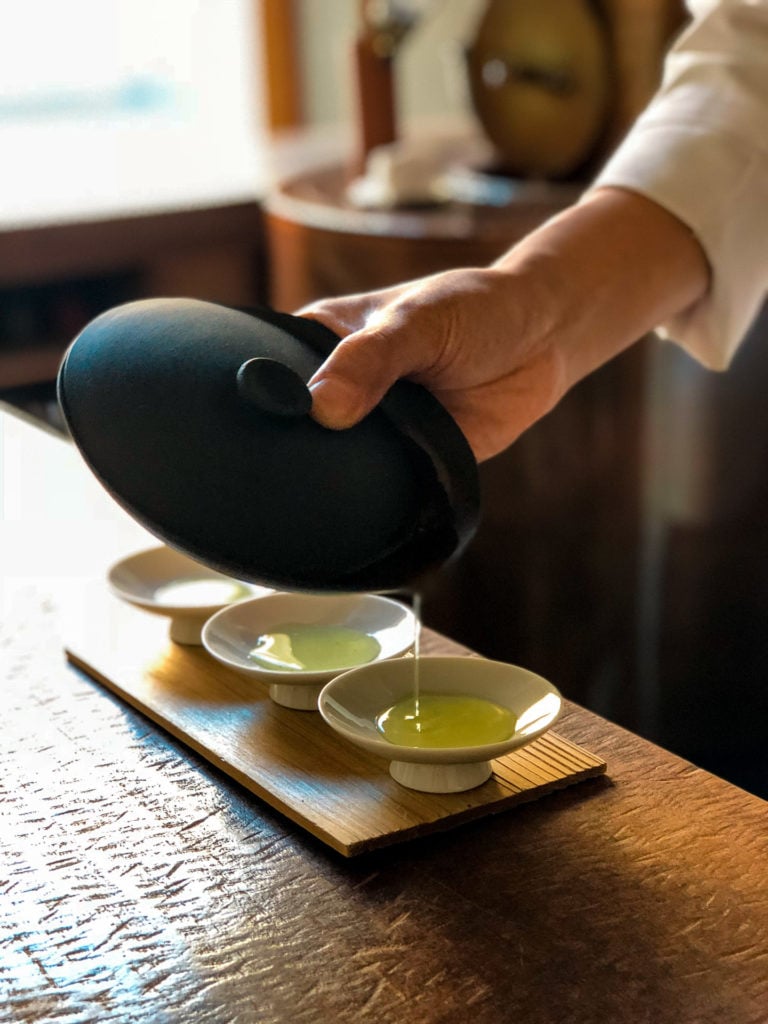
Being the most common drink in Japan there are many varieties of tea to choose from. Here are a few of our favorite teas in Japan.
- MATCHA: Most people who know matcha either love it or don’t. I for one, adore matcha. Matcha is made from shaded tea leaves that are dried and then stone-ground into a fine powder. If you haven’t enjoyed matcha in the past I implore you to try it again in Japan. Ceremonial-grade matcha is creamy with a delicately sweet flavor with notes of almond.
- SENCHA: Sencha is the most popular green tea in Japan. Its flavor differs depending on the area it was grown, production, and harvest. Some sencha has a lighter flavor like white floral notes and fresh grass whereas others are deeper with notes of seaweed and moss.
- HOJICHA: Hojicha is a lightly caffeinated roasted green tea that has a toasted rice flavor. It is one of my favorites!
- GENMAICHA: An exceptionally light green tea that is combined with popped rice creating a flavor of popcorn, barley, and dried seaweed. It is exceptional over ice!
- GYOKURO: If you are someone well-versed in tea and want to try something unique consider gyokuro. It is made from shaded tea leaves and is a rich green tea that has a strong umami flavor with notes of sweetness.
- MUGICHA: Mugicha is another unique tea because it is made from barley. It is caffeine-free and has a toasty, slightly bitter flavor and it is great over ice.
Our favorite tea shops in Japan:
- Yorozu – Fukuoka
- Kagizen Yoshifusa – Kyoto
- Toraya Ichijo – Kyoto
- Itoh Kyuemon – Uji
JAPANESE SAKE
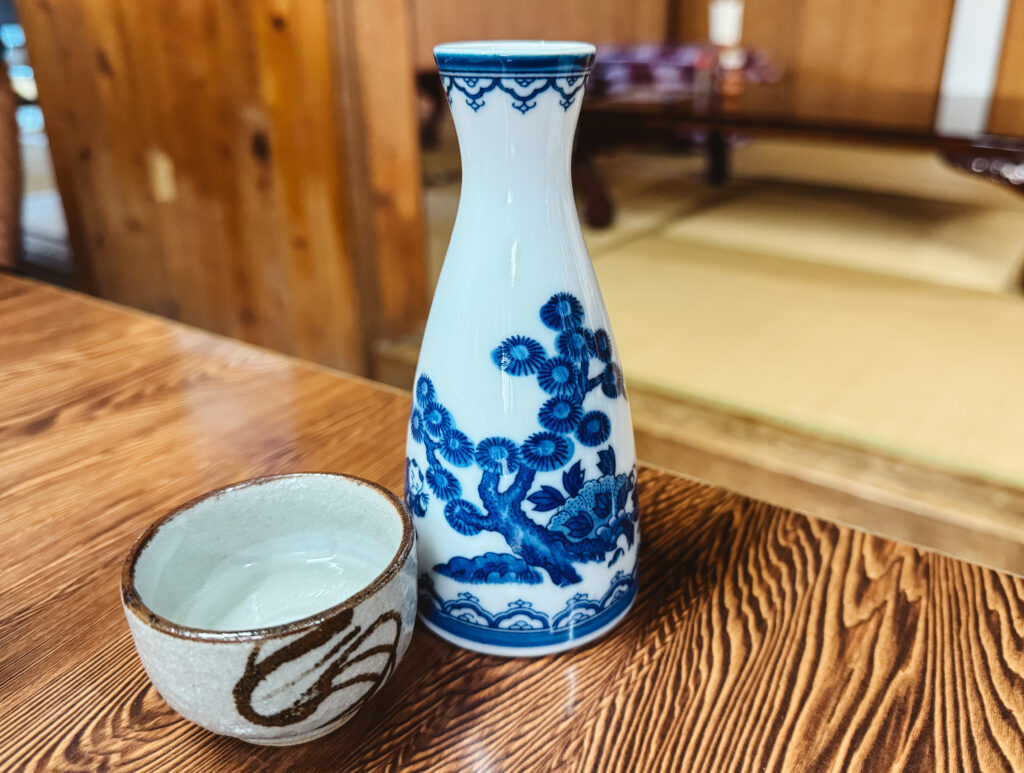
Before visiting Japan the only sake we had tried had been rather strong. While in Japan we tried many different kinds of sake and were pleased with each one we tried. We learned that when buying a brand of sake it is best to find one that includes only ingredients from Japan as it is the purest form. If you are a fan of sake, you should also consider trying Awamori, the famous Japanese liquor from Okinawa.
UMESHU (JAPANESE PLUM LIQUEUR)
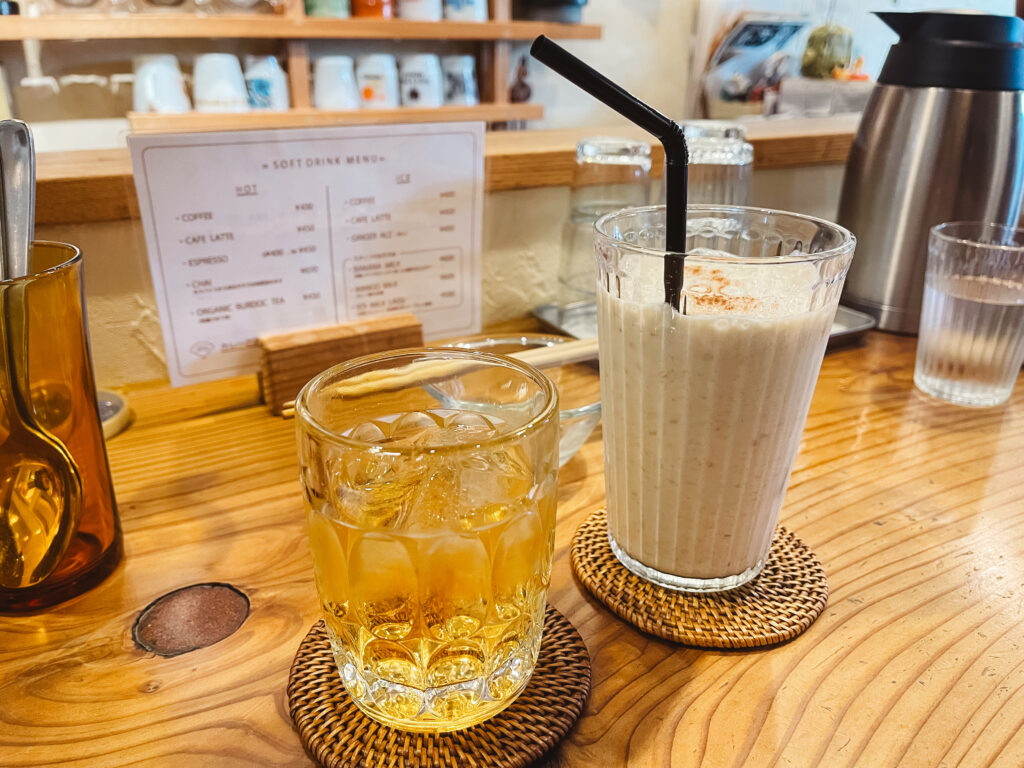
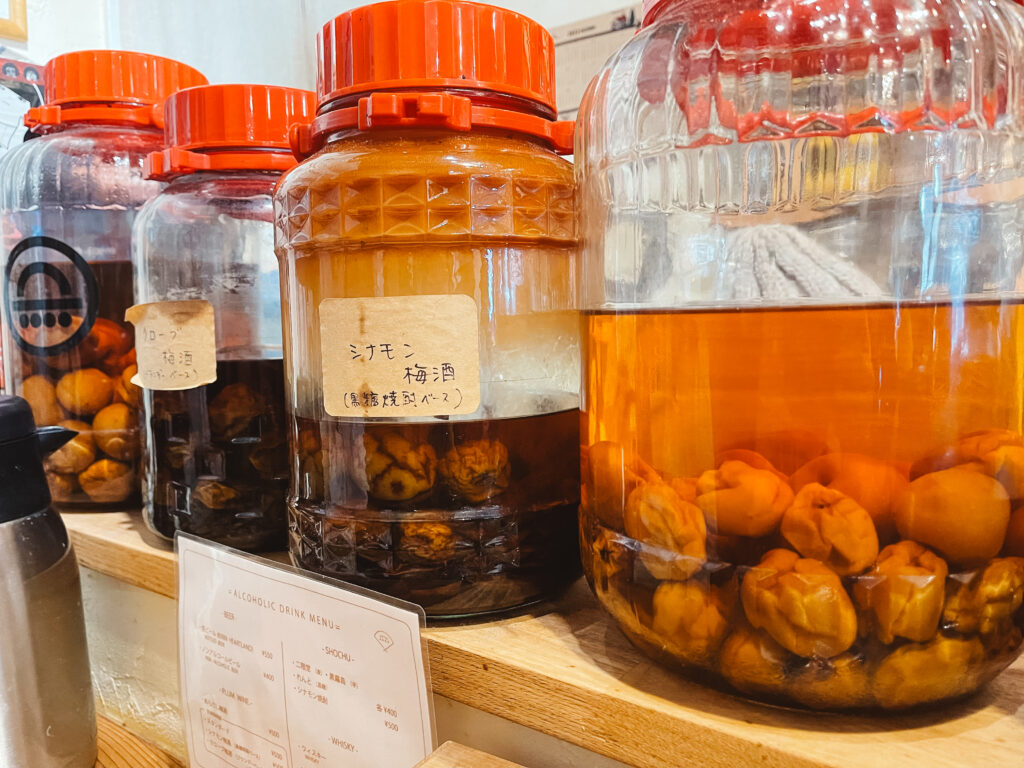
Umeshu is a Japanese plum liqueur made from steeping unripe plums in alcohol and sugar. It has a refreshing sweet and subtly sour flavor. It is commonly served straight, on the rocks, or with tonic water. My favorite is an umeshu soda water which is served with carbonated water. Like sake, there are many brands of umeshu in Japan and you can often find homemade umeshu at izakayas or other small, local restaurants.
BEER IN JAPAN

The four most popular beers include Kirin, Sapporo, Asahi, and Suntory. We tried each and found that they were all similar in taste. Asahi seemed to be the driest brew, followed by Kirin and Sapporo. Another interesting fact is that Japan has vending machines where you can purchase alcohol from as they have no open container laws.
JAPANESE SODA & NON-CARBONATED BEVERAGES
Japan carries Coke and Pepsi products although they are more limited choices than what you might find in the U.S. For instance, I’ve hardly seen Dr. Pepper while in Japan. It is also uncommon to have ice if you order a soda at a restaurant although I have noticed this changes over the years. But one thing is for sure, you’re bound to find A LOT of different soft drinks in Japan!
RAMUNE

Ramune is a carbonated soft drink found widely around Japan. It is known for its unique bottle design and a large variety of flavors including strawberry, lychee, melon, grape, muscat, pineapple, and watermelon.
Other Japanese drinks to try:
- RAMUNE
- MELON SODA
- C.C. LEMON
- MITSUYA CIDER
- CALPIS
- AQUARIUS
- POCARI SWEAT
We hope we gave you some insight into the incredible food to eat in Japan! We never tired of the food or trying new things! What are some of your favorite Japanese foods and beverages?

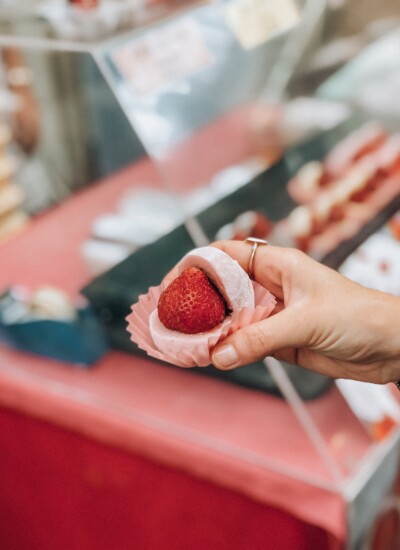
Looking for Japanese desserts to try? This guide to Japanese sweets should do the trick!
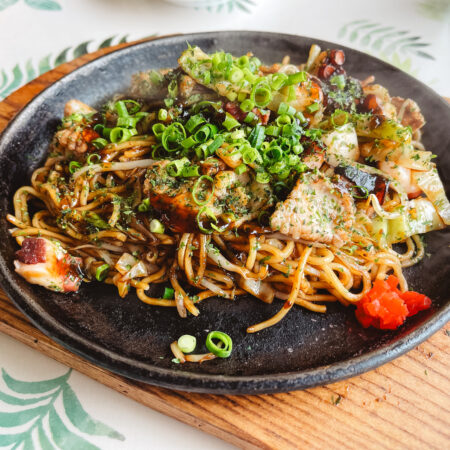
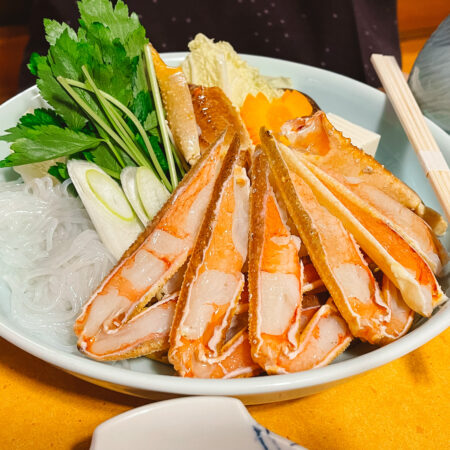
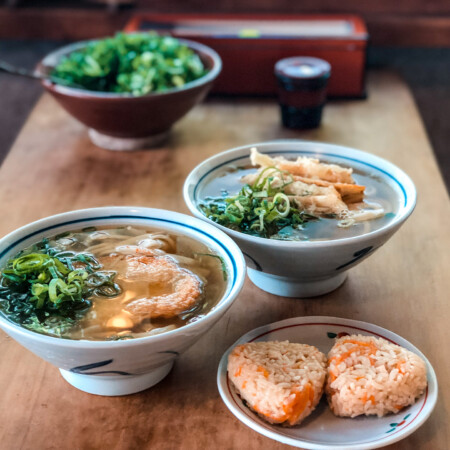
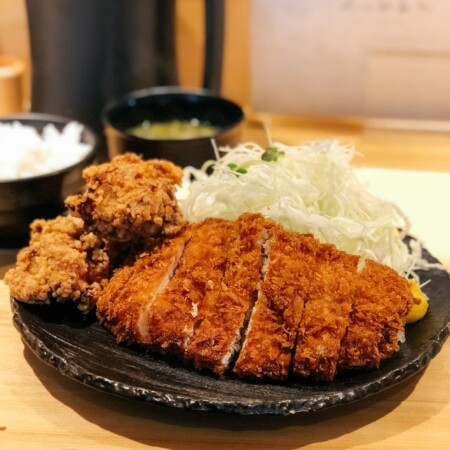
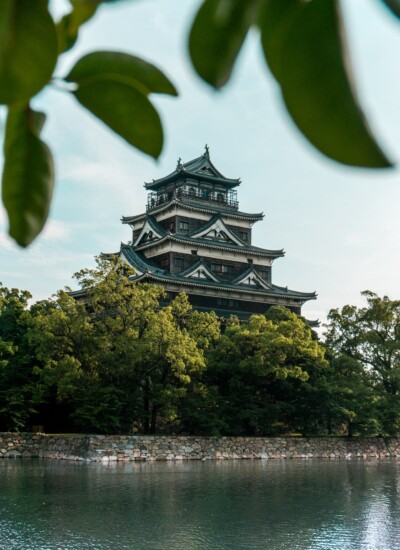


Comments & Reviews
erinklema says
Nice round up of the food you’ll find in Japan. After reading your post, I’m so hungry. I want sushi now. I’ll take some of those adorable doughnuts too, and I’d love to try dango since it is an emoji. 😉
Julie Cao says
Japanese Ramen is my favorite. The sushi plate looks so exquisite and so healthy. Thanks for the round-up for the delicious Japanese food.
kallsypage says
We loved the Ramen too! Thanks for visiting, glad you enjoyed! 🙂
Sanne says
Oh how much I miss the food in Japan! I had a hot pot with a local family, in their home, when I was in Japan. That was probably my favorite food experience there.
kallsypage says
Oh the hot pot! We loved those so much. We have since tried recreating that with our fondue pot but it’s not the same.
Kari says
Holy YUMM that all looks so good! I have always wanted to go to Japan just for the sushi alone! But every single thing looks so good, here I came Japan!
kallsypage says
I’m pretty sure I turned into a walking piece of sushi while there! We ate SO. MUCH. FOOD!
Ricci says
There are lots of choices made me hungry. I love the mochi and gyoza.
kallsypage says
Same here! We recently found some decent gyoza at Trader Joe’s Grocery Store in the States and some Mochi Ice Cream. It’s satisfying us for the time being!
Bhushavali says
OMG! That’s a long long list. That’s actually a very educational post with so many technical terms!!! I’ve never had Japanese food so far and I know, its high time, I should get into an authentic restaurant and try a few dishes!
kallsypage says
It is a rather lengthy list but all of them are worth trying! If you like any type of Asian cuisine you will most likely LOVE authentic Japanese.
Anna Sherchand says
Great list guys! I tried home made Okonomiyaki at a Japanese friend’s house in Kyoto and absolutely loved it :
kallsypage says
Thank you Anna! Okonomiyaki is so delicious and not to mention, a LARGE portion every time!
Snigdha says
I love Japanese food. Although it’s an acquired taste but I find it simply yummilicious. My favorites are tempura, soba, and okonomiyaki. Love your read. I’m still drooling.
kallsypage says
Thank you very much Snigdha! Tempura became a fast favorite of mine as well. In fact, I’m kind of obsessed with ALL Japanese food. 😉
kallsypage says
Thank you very much! I couldn’t agree more but obviously having sushi there is out of this world! 😉
ADAM DOOLITTLE says
Officially hungry now! For a long time I’ve wanted to travel to Japan, mostly for the culture but now after reading your post I definitely wanna go for the food, too! There are so many delicious look dishes here from the dumplings to the sushi to the noodle dishes…and of course, the crepes! Those look absolutely amazing 🙂
Brigitta says
*drooling* I want to try EVERYTHING on this list! 😀
Kallsy Page says
Still drooling thinking back on it!